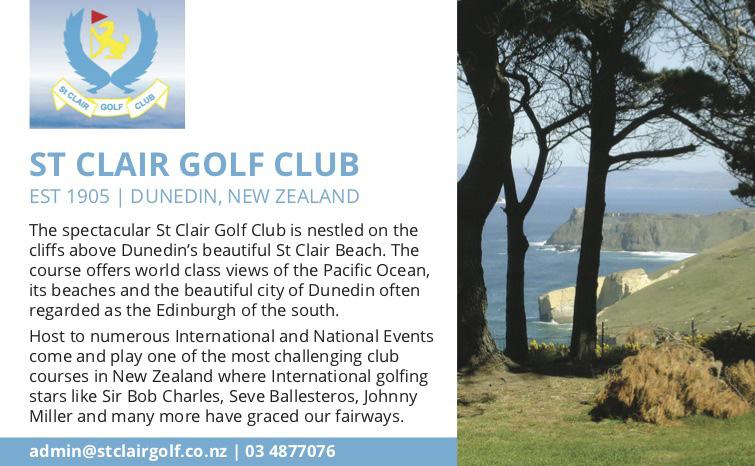

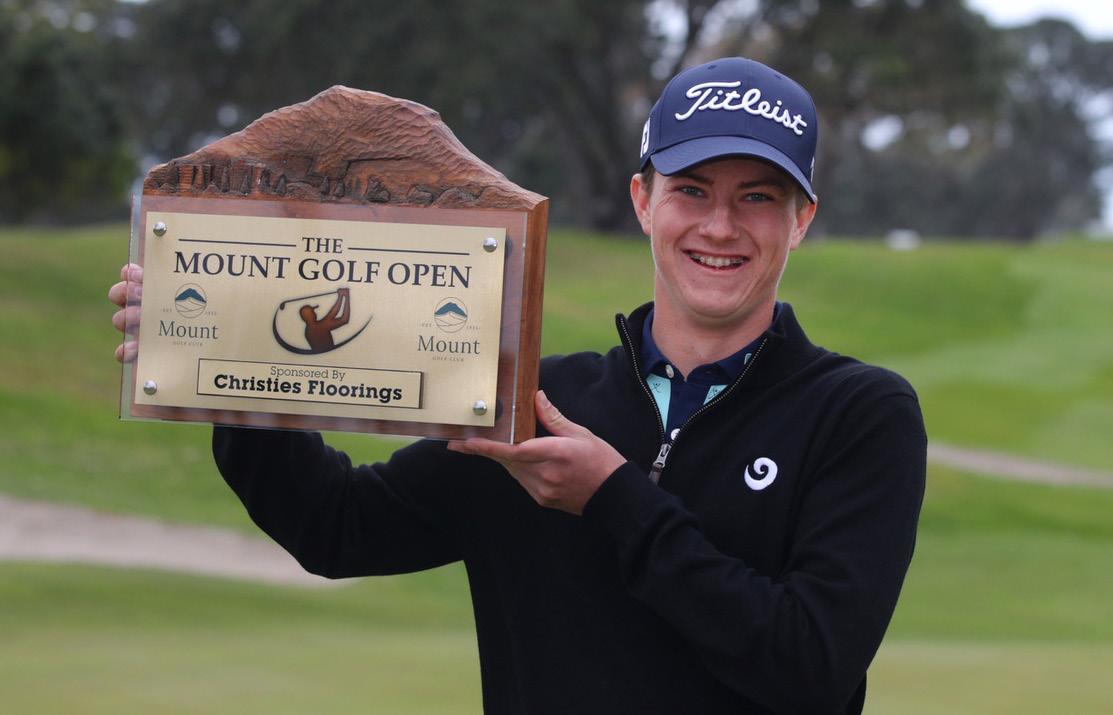



pgueorgieff@yahoo.co.nz







pgueorgieff@yahoo.co.nz
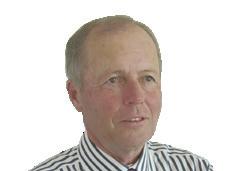
By Paul Gueorgieff Editor, Golfer Pacific NZ
Iwas a little confused.
I was watching the British PGA Championship at Wentworth in England last month when the television commentators mentioned two cuts for the tournament.
I thought that’s interesting but didn’t really understand what it was all about. I just thought two cuts was part of the tournament from the outset and things would sort themselves out.

But that was wrong.
The reason that two cuts were introduced was because there was a very high number of players who made the first cut — 86 to be exact.
The normal cut line for DP World Tour events is the top 65 plus ties and 86 was considered too many.
The tournament director of DP World Tour events has the discretion to introduce a second cut when there is a very high number of players make the first cut and it was decided this was an appropriate occasion to invoke the rule.
It was only the second time in nearly three years such a decision has been made on the DP World Tour. The previous time was in the Dubai Desert Classic in 2023.
The first cut line was two under par and there were 26 players on that score which was an unusually high number.
The second cut saw the field reduced to 73 players and amongst those to miss out was one of the tournament’s top players, Scotsman Robert MacIntyre.
Those that missed the second cut still got prize money.

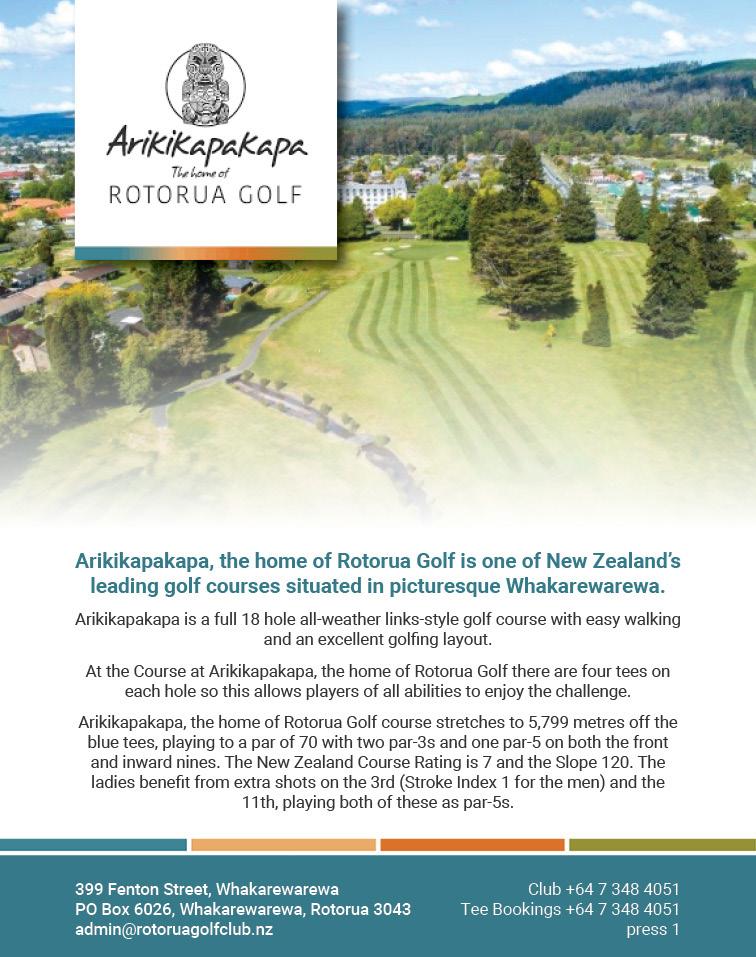
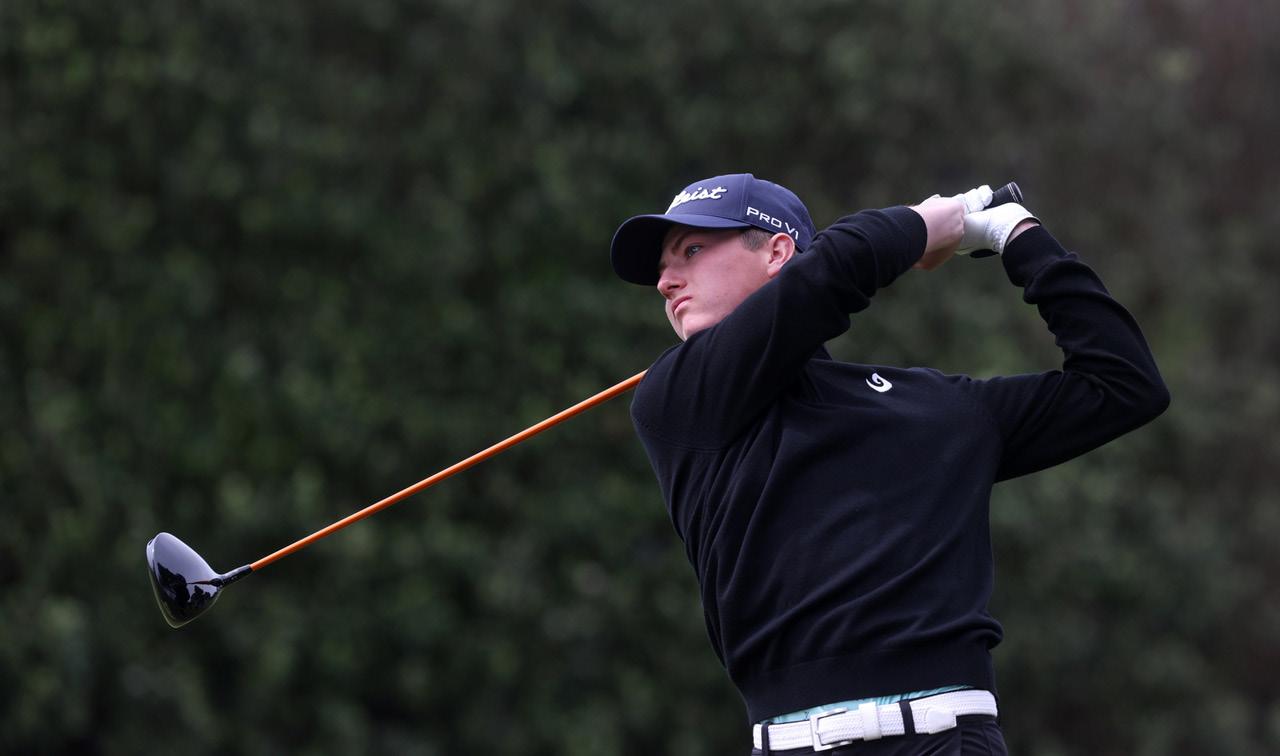
The Mount Open at Mount Maunganui Golf Club in Tauranga delivered four days of drama, storylines and breakthrough performances capped by 17-year-old Golf New Zealand academy player Cooper Moore claiming his first Charles Tour title last month. Challenging conditions on day one of the tournament sponsored by Christies Floorings made scoring difficult and favoured the early half of the draw. Defending champion Josh Geary set a blistering pace with seven birdies, but a double bogey on the par five 15th saw him close at four-under par. Kerry Mountcastle scored an eagle on No 13 on day one and finished two-under par, while Ricky Kang raced to four-under through four holes before a tough back nine left him at even par.
Day two brought improved morning conditions before wind and rain returned in the afternoon. Sam Jones posted the lowest round of the tournament to that point, firing a six-under 65 with five birdies and an eagle to reach nine-under overall. Moore rebounded from a one over par start with a superb 66 in the second round that lifted him 15 places, while Tyler Wood was the biggest mover of the day,
climbing 35 spots with a three-under round. Luke Kidd also rocketed into contention, producing five birdies and an eagle in a blistering run of six straight threes. Near-perfect Saturday conditions paved the way for low scoring in round three, and Mountcastle took full advantage. The former New Zealand Amateur champion produced a bogey-free eight-under 63 – the lowest round of the tournament – with eight birdies to move into solo second. Moore backed up his strong second round with another five-under 66 to stay in the hunt, while Jones overcame a rough start to card a steady 68 with six birdies. Geary’s mixed form continued, finishing even par to sit seven shots adrift. In the women’s field, Yoonae Jeong edged ahead of Amy Tang by one shot, with Chloe So a further six shots back.
Overcast and chilly conditions greeted the players for the final round, and the leaders wasted no time getting below par; Mountcastle, Moore, and Jones all opening with birdies. Geary also birdied the first as he chased back-to-back titles.
The tournament was turned on its head when Jones suffered a disastrous sextuple bogey 10 on the

par four third. To his credit, he responded with grit, steadying his round with a par at the fourth and a birdie at the par five fifth. Meanwhile, Moore’s Golf New Zealand academy teammate Yuki Miya surged into contention with four birdies in his first five holes.
At the turn, Mountcastle remained bogey-free and two-under par, matched by Moore as the pair set themselves apart.
The decisive moment came on the par three 17th with the pair tied at 12-under, where Moore hit a precise tee shot and rolled in the birdie putt to edge one clear. Mountcastle could only make par. Both players found the green at 18. Mountcastle nearly forced a playoff with a 20-foot birdie putt that agonisingly hung on the lip of the hole, leaving Moore to calmly two-putt for par and the victory as the rain began to fall.
In the women’s amateur field, another Golf New Zealand academy member Chloe So completed a huge turnaround with a one-under 70 on the final day to finish three shots clear of Yoonae Jeong in second after there was a three-way tie for the lead heading into the back nine to collect top amateur honours.
The win marks Moore’s first Jennian Homes Charles Tour title after coming close earlier at Race to Tieke, where he narrowly lost to Michael Hendry. At just 17 years old, the victory underlines his status as one of New Zealand golf’s brightest rising talents. Moore said heading down the stretch in contention and eventually the lead could have been overwhelming as he’d been in a similar position before and not come away with the win, but he turned to his processes and trusted himself to remain calm.
“I probably went straight into my processes and sort of just stuck to them, I believed in them all week and it was nice to get over the line and it’s a big boost heading into the next few weeks.
“I was quite nervous, I had a similar situation at Race to Tieke and let that one slide so didn’t want to let another chance slide.”
With two putts for victory Moore hit his first a few feet past the hole and had a tricky par putt to close it out after Mountcastle’s near miss. Moore said he was relieved to see the final one drop to applause from the gallery.
“First one hit a little bit firmer than I would have liked,” Moore recalled.
The win sets Moore up for a busy stretch including a 2025 Eisenhower Cup campaign in Singapore and swiftly followed by a trip to the United Arab Emirates to compete at the Asia-Pacific Amateur Championship.

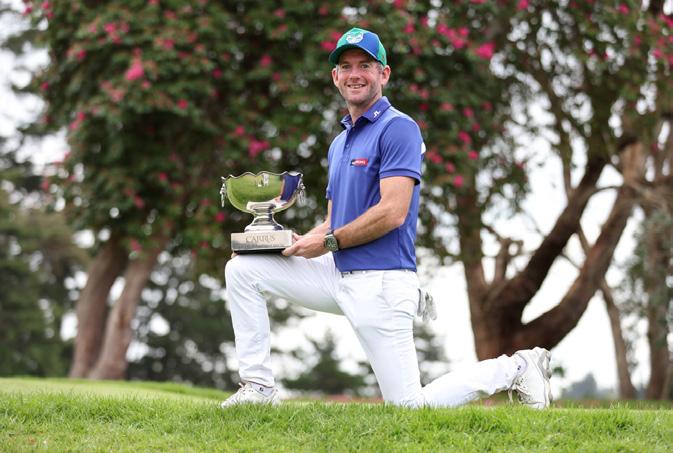
Josh Geary successfully defended his Tauranga Open crown at Tauranga Golf Club last month, going wire-to-wire to secure back-to-back titles on New Zealand’s Charles Tour.
The local favourite showed his class across four consistent rounds, finishing at 29 under par after a stunning final round 60 to claim victory by a record 12 shots. It was a dominant display from start to finish, underlining once again why Geary remains one of New Zealand’s most formidable golfers.
The Tauranga Open, sponsored by Carrus, produced another thrilling week of golf with low scoring, late drama, and a tight battle for the women’s title adding to the spectacle.
Jayden Ford set the early pace in round one with a front nine of four under par, reaching eight-under through 13 holes after an eagle at the par five 13th. His charge briefly put him on a ``59 watch” before a bogey on the par three 14th halted momentum.
He recovered with a birdie on 15 but closed with two pars and a bogey on 18 to set the clubhouse target at seven-under.
Kit Bittle also got off to a hot start at three-under through four after showing good form the week prior at the Mount Open while Steven Oh carded four-under through his first six holes. Fresh off his breakthrough win at the Mount, 17-year-old Cooper Moore looked composed with a three-under round that included just one bogey.
Golf New Zealand academy player Mitch Kale matched that effort, showing promise in front of a supportive home crowd. Defending champion Geary opened strongly in the afternoon, bogey-free through 14 and joining Ford at seven-under, while Yuki Miya continued his consistent stretch of golf to post a four-under opener.
In the women’s field, Chloe So carried over her form from top amateur honours at Mount Maunganui to take a two-shot lead after day one, with Faith Vui close behind in second.
On the Friday, Geary underlined his title defence with a steady four-under 66 that moved him four shots clear of the field at the halfway mark. Matt McLean surged early in his second round, four-under through nine, only to slip back with a two-over inward nine and finish tied for 10th at three-under.
Dominic Brettkelly also made an early charge, five-under through eight, but his round unravelled with two doubles and a bogey, leaving him even for the tournament. James Hydes battled through a mixed day, bouncing back from a shaky start to his back nine to finish one-under and move to six-under overall, tied for fourth.
Miya stayed in contention with a two-under 68. The big movers came from further back as George Hodgson rebounded from a one-over

opener with a six-under 64 to climb 20 places, and Ricky Gyeom of Korea overturned a slow start to move into a tie for second at eight-under.
The standout performance belonged to Oscar Guo, who surged 51 places with a bogey-free seven-under 63, highlighted by five birdies and an eagle, to move into eighth. The women’s field remained tightly packed, with only four shots separating first from 11th. Amy Tang recovered from a seven-over opening round to post even par in round two and set a promising platform for the weekend, while Vui improved by three shots to sit second. With only two strokes covering the top five, the leaderboard promised further movement over the final two days.
The third day, known as moving day, delivered on its reputation, with Luke Kidd threatening to go very low after a front nine of five-under that briefly raised the prospect of a 59, only to fade on the back nine.
Moore climbed into the top 10 with a six-under 64, while Geary showed no signs of slowing, birdieing his opening two holes and staying bogey-free en route to a six-under round that stretched his lead to five shots heading into Sunday. Miya hung tough with a five-under 66 to remain within striking distance, while Hydes made his presence known with a brilliant eight-under 62, capped by birdies on 17 and 18, to join the chase.
In the women’s event, the lead changed hands repeatedly between Hunter Edwards, Queenie Lang and Tang. Lang appeared to seize control late, but a bogey on 18 opened the door for Tang to draw level, setting up a tense final round. Chloe So also closed the gap with a stronger perfor-
mance, while Ashlesha Sirigiri kept herself within range, just seven shots off the pace.
Geary entered the final day with the luxury of a five-shot cushion, but any thoughts of a tense finish were quickly erased as he birdied the second and third holes to stretch his lead to seven. From there he assumed total control, marching into the back nine at a record pace.
At seven-under through 12, he had the crowd murmuring about another possible 59. While that mark ultimately eluded him, he poured in birdies across the back nine to finish with a stunning 10-under 60, posting 29-under for the week and cruising to victory by 12 shots – the largest margin in Jennian Homes Charles Tour history.
Ford began brightly with back-toback birdies but couldn’t sustain his early momentum, while Miya and Hydes stayed bogey-free but were unable to find the birdie runs needed to close the gap on the champion.
The women’s finale was just as dramatic, with Tang and Lang beginning tied for the lead but faltering with bogeys on the front nine. Tang briefly pulled ahead with a birdie on seven, only for her back nine to unravel. So launched a late charge, reaching three-under through 17 after an eagle at the 15th, but a closing bogey on 18 saw her fall just short. That left the door open for Hunter Edwards, who produced the lowest round of the day with a composed three-under 69. Her steady play earned her the women’s title by a single stroke, a breakthrough victory built on resilience and timely birdies down the stretch.
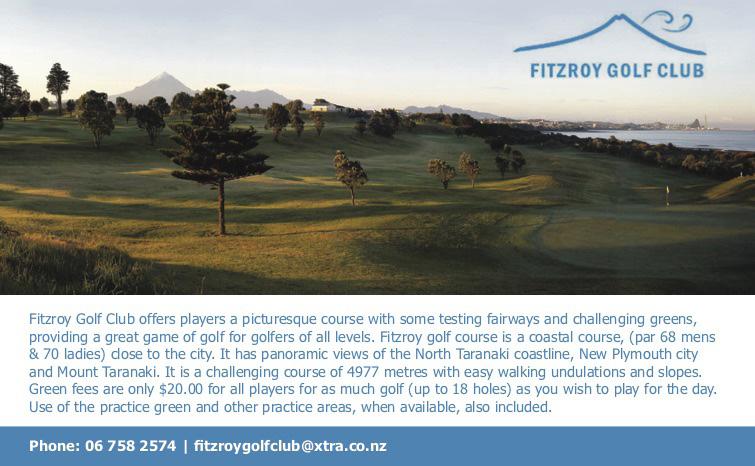

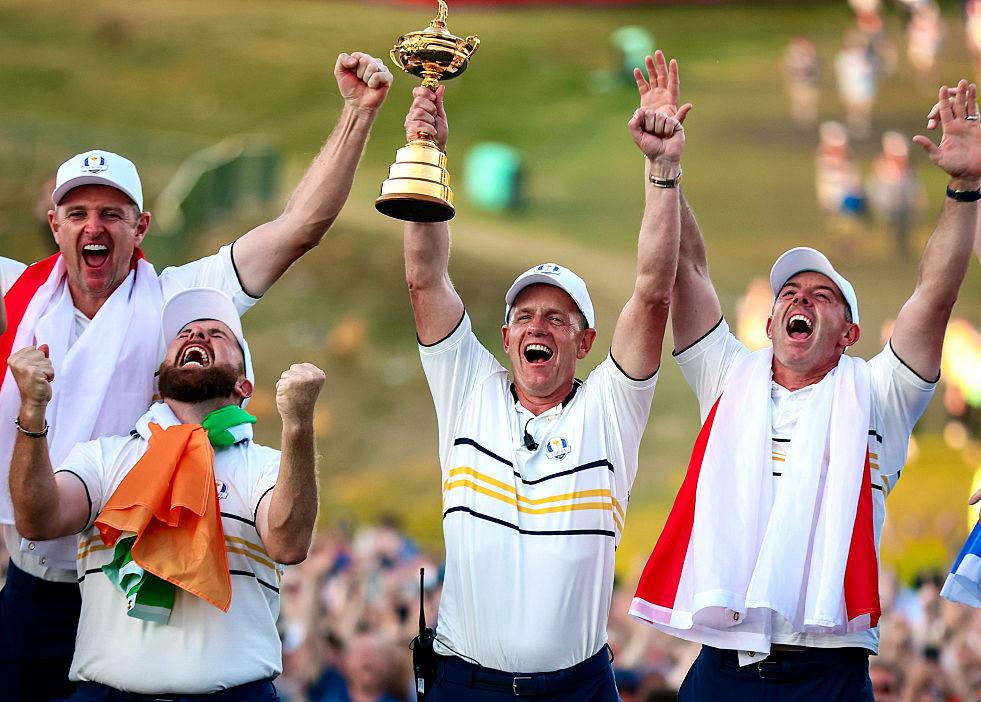
By Paul Gueorgieff, editor Golfer Pacific
It was looking like a cakewalk for the Europeans but hats off to the United States team for its fight back on the final day of the Ryder Cup.
The United States was down 11-1/2 to 4-1/2 after the first two days of the cup and needed the highly improbable feat of 10 wins from the 12 singles matches on the final day of the tournament at Bethpage near New York.
It wasn’t to be but the United States came very close. The Americans racked up six wins and five halves to tie the record for the most points in the singles’ session of a Ryder Cup.
The final result was 15-13 to the Europeans to give Europe its 11th win in the last 15 Ryder Cups. It was also Europe’s fourth win in the last eight starts in the United States in the biennial event where the venue rotates between the United States and Europe.
The crowd had been highly
vocal for the first two days — both good and bad — and it had much to cheer about on day three.
The Europeans needed just 2-1/2 points on the final day to reach the necessary 14 points to retain the cup and it was looking well in hand when Englishman Justin Rose birdied holes 12, 13, 14 and 16 to draw level with New Yorker Cameron Young.
What appeared to be a valuable half-point for Rose was snatched from him by Young who birdied the 18th for the win and have the American crowd pumping.
American captain Keegan Bradley’s response of Young’s win was: “He went out there in front of the whole world, in front of his home state, and made a 10-footer to beat Justin Rose, who is an all-time Ryder Cupper.”
It was just as electric minutes later when Justin Thomas (USA), who had been two down through seven, was centre-cup with a 12-footer to beat Tom-
my Fleetwood one up. That made the scoreboard 12-8 but more importantly, of the six matches still in play, the US led in four, trailed in one, and another was all square.
The impossible suddenly felt possible. Even European captain Luke Donald knew it.
“It’s been the most stressful 12 hours in my life,” Donald said afterwards.
“Shout-out to the Americans … I knew it would be tough. I didn’t think they would be this tough.”
A wave of momentum could be felt for the Americans and perhaps it started with Bryson DeChambeau, who was five down through seven. But with relentless fury, he won five holes between 8 and 17 and while he didn’t win the 18th, he scratched out a half against Matthew Fitzpatrick.
The win of Swedish player Ludvi Åberg’s soon followed and when you mixed in the half-point that came with Viktor Hovland’s withdrawal with injury before the start of play, the Europeans were at 13-1⁄2 points. At this time, in the wildness, the mission from Donald for his players was as clear as the sky above Bethpage: Halves were like gold bullions, it wasn’t just win, it was scramble for the tie.
Each of the last four matches provided an opportunity.
Irishman Shane Lowry was one down on the 18th tee. Rasmus Højgaard (Europe) trailed Ben Griffin by one on 17. And then there were the matches between Tyrrell Hatton (Europe) and Collin Morikawa and Robert MacIntyre (Europe) which were both very close.
But the Europeans wanted more than 14 points to halve the match. They wanted at least 14-1⁄2 points to win out-

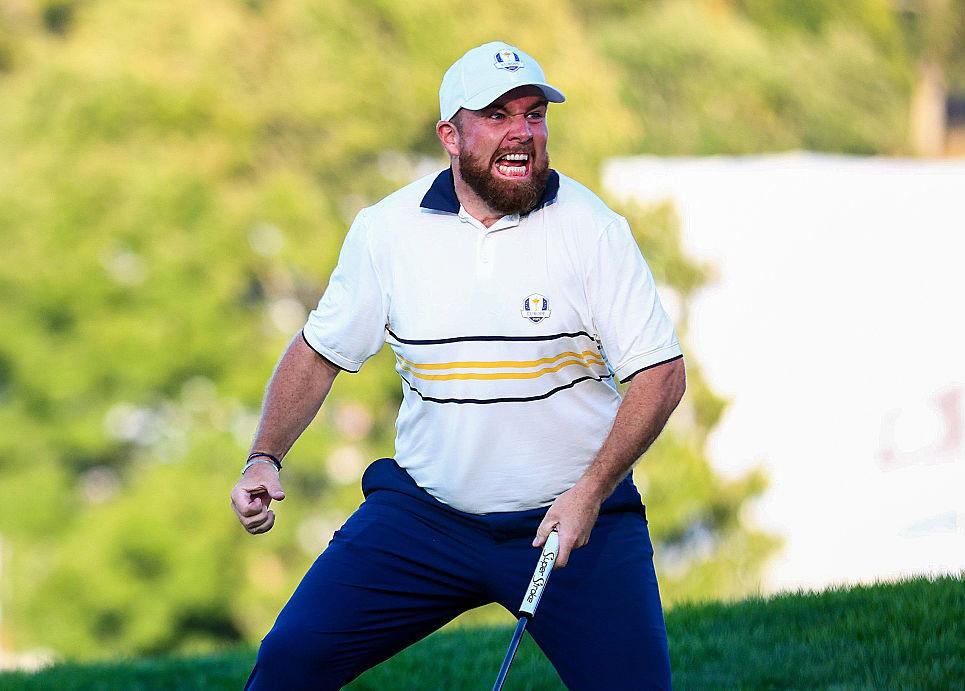
right.
They did a little better. Lowry birdied the 18th to get all square with Henley, earning the magical half-point to clinch the Ryder Cup. (Shades of Irish eyes smiling in 2002 when Paul McGinley did the honours at the Belfry.)
The cup won, Hatton and MacIntyre both earned their halves, thus creating a 15-13 final result, though it will forever be Lowry who will bask in the spotlight of the 2025 Ryder Cup.
“That was the hardest couple of hours of my whole life,” said Lowry through tears of joy.” He had led early but fell two down through 14, knowing his game meant so much.
“I said to Darren (Reynolds, his caddie) walking down 18, I have a chance to do the coolest thing of my life here. The Ryder Cup for me is everything and to do that there today on the 18th green in front of everyone … ”
It was awe-inspiring is what it was. From 108 metres, Lowry
pierced the air with a brilliant approach to six feet. When Henley missed his 10-footer for birdie, history beckoned the Irishman and he seized the opportunity.
But he was quick to pay tribute to an American effort that just fell short of a historic bid.
“Fair play to the US lads,” said Lowry. “We knew they were going to come out fighting.”
That they did, only the hole they had dug for themselves Friday and Saturday proved too deep. But it didn’t make them overlook what they had nearly accomplished.
Said American Scott Scheffer, who earned a brilliant one up win over Rory McIlroy, his first win in five matches: “I can’t speak enough to the fight that these guys have in this room.
“After the butt-whooping we got the first two days of this tournament, to come back today and play like we did … I think it really shows a lot of heart.”

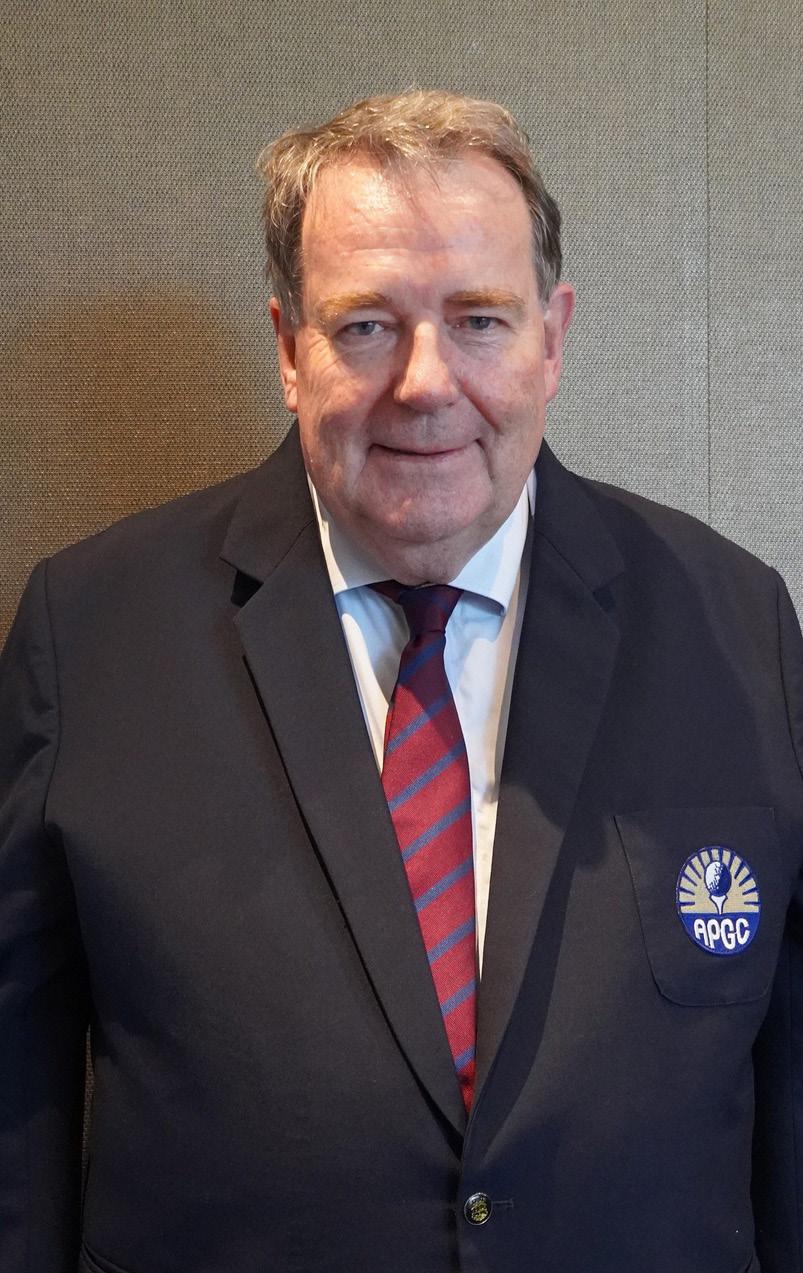
Philip Hassall of New Zealand is to become the next chairman of the Asia-Pacific Golf Confederation (APGC), which is the regions’s ruling golfing body.
Hassall, who has served as a director of the APGC for 15 years and is currently vice chairman and treasurer, will be the fifth chairman of the confederation following Malaysian Tommy Lee (19992014), Australian David Cherry (20142017), Japan’s Kei Muratsu (2017-2019) and current chairman Taimar Hassan Amin (2019-2025) of Pakistan.
“I’m excited at what the future holds for golf across the Asia-Pacific region – and for the APGC,” said Hassall, who has also been a key figure within Golf New Zealand, acting as chairperson of the amalgamated men and women’s Golf New Zealand for seven years, followed by six years as Golf New Zealand president. He is now a life member.
“The potential for the game to continue growing is tremendous with the APGC at the forefront,” added Hassall, recent-

ly retired as chief executive of Hamilton Radiology and Midland MRI Ltd after 21 years of service. The companies have 17 clinics, employing 144 staff across the Waikato and Bay of Plenty region.
General Abdulla Al Hashmi from the United Arab Emirates has been confirmed as the next vice chairman of the APGC. The new positions will be confirmed at the confederation’s annual meeting in Dubai next month when Amin will stand down.
Amin said: “These are exciting times for Asian golf in general, and for the APGC in particular. I have every confidence that the new chairman-designate Philip Hassall and vice chairman General Abdulla will guide the confederation with wisdom and vision. Under their leadership. I’m sure the region’s rise in the global golfing world will continue.
“We are indeed fortunate to have such experienced individuals stepping into these roles. Both have dedicated many years to the game and are deeply respected, not only in their home countries but also throughout Asia-Pacific.”
General Abdulla joined the UAE Air Force as a pilot, going on to become flight commander and base commander in charge of training in the Air Force.
In 2008, he became the UAE defence attaché to Australia and New Zealand. Returning to the UAE in 2013, he was appointed as assistant under-secretary at the Ministry of Defence.
During his youth, he excelled at volleyball and represented the UAE in ice hockey before going on to captain the UAE Air Force soccer team. It was during his spell in Australia that he took up golf and developed a love for the game.
Now retired, General Abdulla, currently serves as president of the Emirates Golf Federation as well as being a board member of the UAE national Olympic
committee.
“I’m honoured to be appointed as vice chairman of the Asia-Pacific Golf Confederation and look forward to contributing to further elevating the status of golf in the region and the APGC on the global stage,” said General Abdulla.
Reflecting on his tenure as chairman, Amin said: “For me, it has been a privilege and a true honour to serve as chairman of the APGC over the past six years. I look back with pride on what we have been able to achieve together – the resumption of our championships after the challenges of the covid-19 pandemic, the strengthening of our relationships with The R&A and Augusta National, and the continued association with our long-standing partners Rolex and new sponsors Kabaya Ohayo Holdings, with whom we have teamed up to stage The Royal Junior championship in Japan.
“We’ve also seen the launch of new events such as the APGC Mid-Amateur Championship and the introduction of the APGC Senior Ladies’ Championship, while our ties with the European Golf Association (EGA) have further developed. Some of the most memorable moments came when our teams triumphed against strong EGA line-ups in the Bonallack Trophy in 2023 and 2025, and this year’s Patsy Hankins Trophy. These victories showcased the strength of golf in our region and the talent we are nurturing for the future.
“As I step down, I do so with immense gratitude – to my board members, to our member national associations, our small team of hard working staff, and to the many friends I have made along this journey. While my tenure as chairman comes to a close, my commitment to the game and to the APGC will always remain. I look forward to seeing the confederation grow even stronger in the years ahead.”
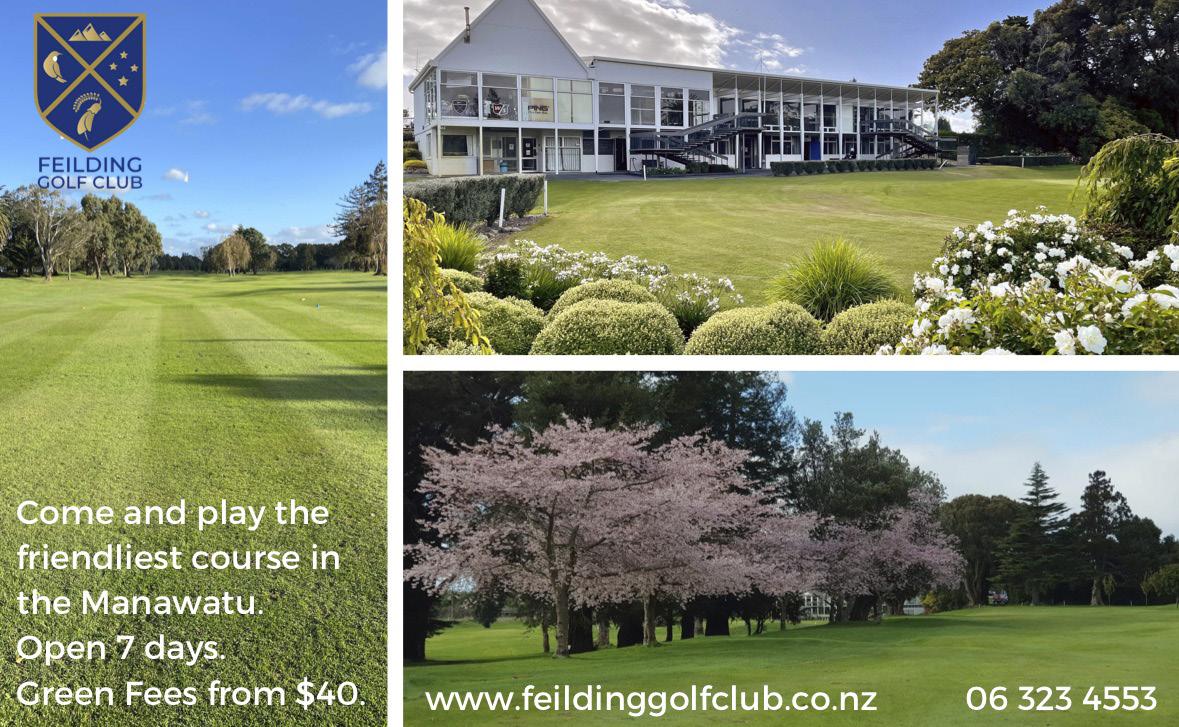
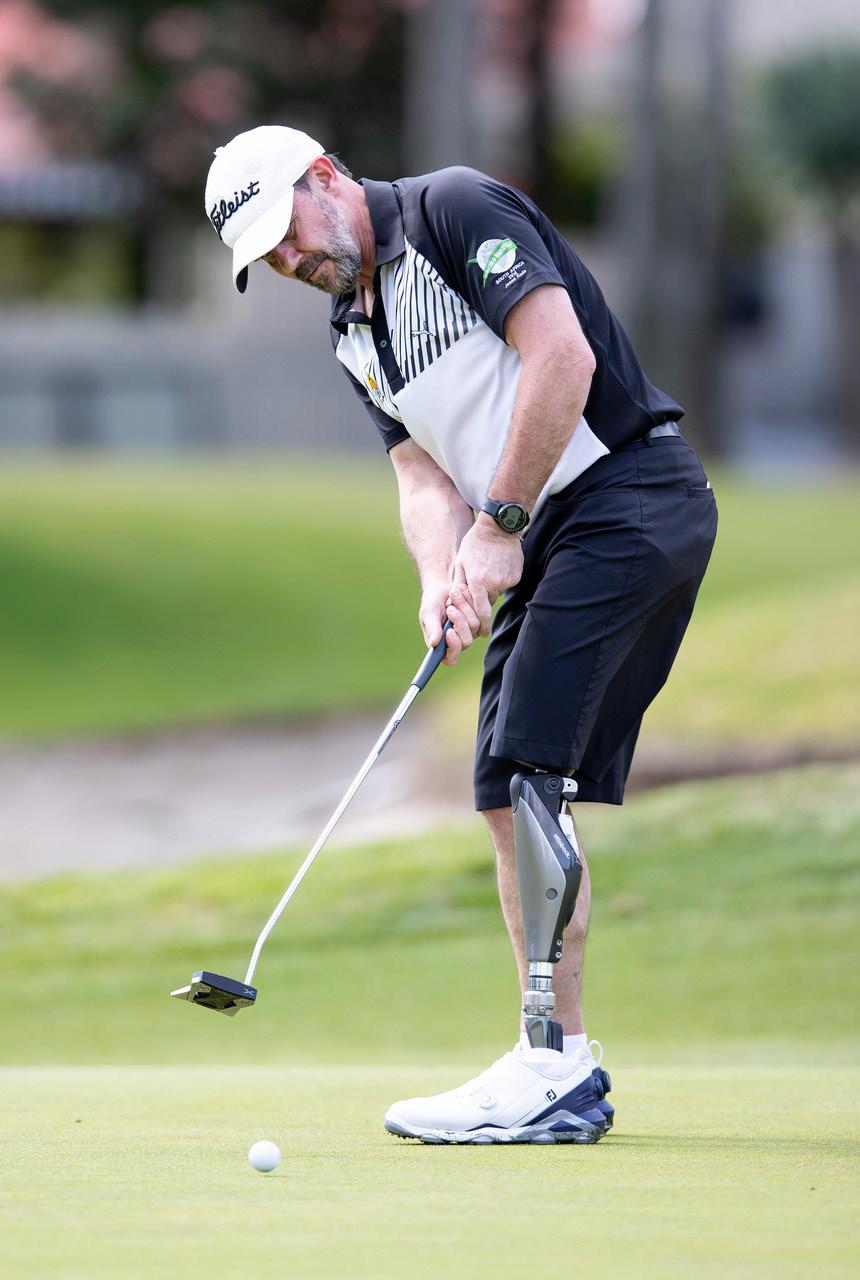
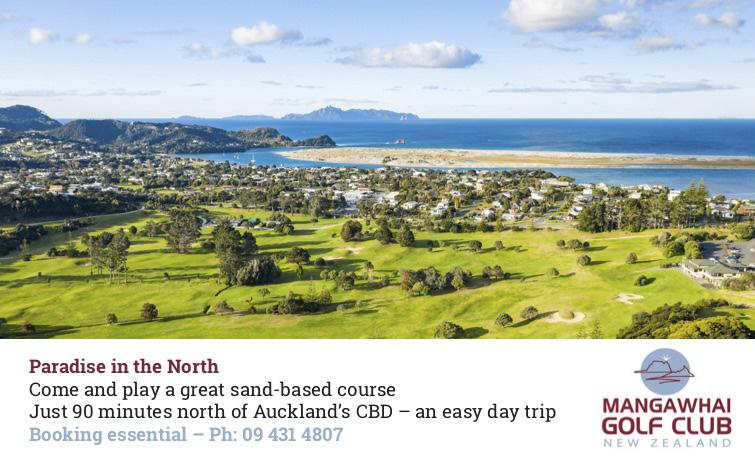
Three decades ago, I was a 22-yearold boxer with Olympic dreams.
I had been selected to represent New Zealand at the 1992 Olympic Games in Barcelona, and everything in my life was building toward that one goal. But in a split second, everything changed.
It was a crisp afternoon in 1991 and I was riding my motorbike near Kaiapoi, just north of Christchurch. The sun was low in the sky, and as I rounded a bend, I was completely blinded by sunstrike. When my vision returned, I was heading straight for a lamppost. I didn’t have time to think—only react. Instinctively, I ducked, using a move I’d honed through years in the boxing ring.
That decision saved my life.
The impact was massive. My left leg was severed at the knee. I was lying on the side of the road, stunned, in a pool of blood. A bystander—someone I’ll never forget—fashioned a tourniquet and kept me alive until help arrived. I was rushed to Christchurch Hospital, and by that night, doctors had made the call to amputate above the knee.
My right leg was also badly broken, but somehow, I escaped without internal injuries. I remember lying in the hospital bed that night, staring at the ceiling and thinking, “Man, I’m lucky to be alive.” But at the same time, the weight of what I’d lost was overwhelming.
I had gone from being an elite athlete preparing for the Olympics to someone learning to walk again.
The early days were tough. I had no idea what the future looked like. How would people perceive me now? What would life be like living with a disability? At 22, I had to start over – physically, emotionally, and mentally.
But I didn’t want to be defined by my injury.
With support from the Accident Compensation Corporation (ACC), I threw myself into rehabilitation. They were with me every step of the way – medical care, prosthetics, vehicle modifications, you name it. That support gave me the foundation to not just recover, but to rebuild.
I dabbled in wheelchair sports – tennis and rugby – but they didn’t quite fit. Then, in 2007, I went along to a work golf tournament. I picked up a club, took a swing, and something just clicked. I hit a few decent shots and thought, “You know what? I can do this.”
So I taught myself how to play.
Fast forward to today – I’m a 10 handicap golfer, playing every weekend at Royal Wellington Golf Club. My best round? An even-par 72 at Manor Park in the Hutt Valley where I also notched up a holein-one. In 2022, I won the New Zealand Disability Golf Championship, and more
recently, competed in the New Zealand All Abilities Championship.
I love golf because, like life, you never truly master it. Every round is a new challenge. It’s humbling and rewarding at the same time.
What means even more to me now is the opportunity to show younger players – especially those living with disability –that sport is still possible. I’m 56 now, and beating the young fellas is a nice bonus. But my real drive is to be a role model. I want others to see that, yes, life throws curveballs – but there’s still so much to live for.
Outside of golf, I’ve worked at the InterContinental Hotel in Wellington for over two decades. I started as a porter and now I’m the chief concierge, leading a team of 12. It’s a physically demanding job – long days on your feet – but I’ve never made excuses. If anything, I’ve worked harder to prove what’s possible.
I’ve even won a couple of international awards for hotel excellence. But for me, the greatest reward is showing up every day, leading my team, and being part of a community.
If I could give one piece of advice to anyone facing a life-changing injury, it’s this: You have a responsibility to yourself to keep living. You only get one shot at life. Don’t waste it.
The crash ended one chapter of my story – but it also opened another. And standing over a pressure putt to win a championship, I know this for certain: I’ve faced far tougher moments. And I’m still here.
Still swinging. Still living. And still chasing the next great shot.
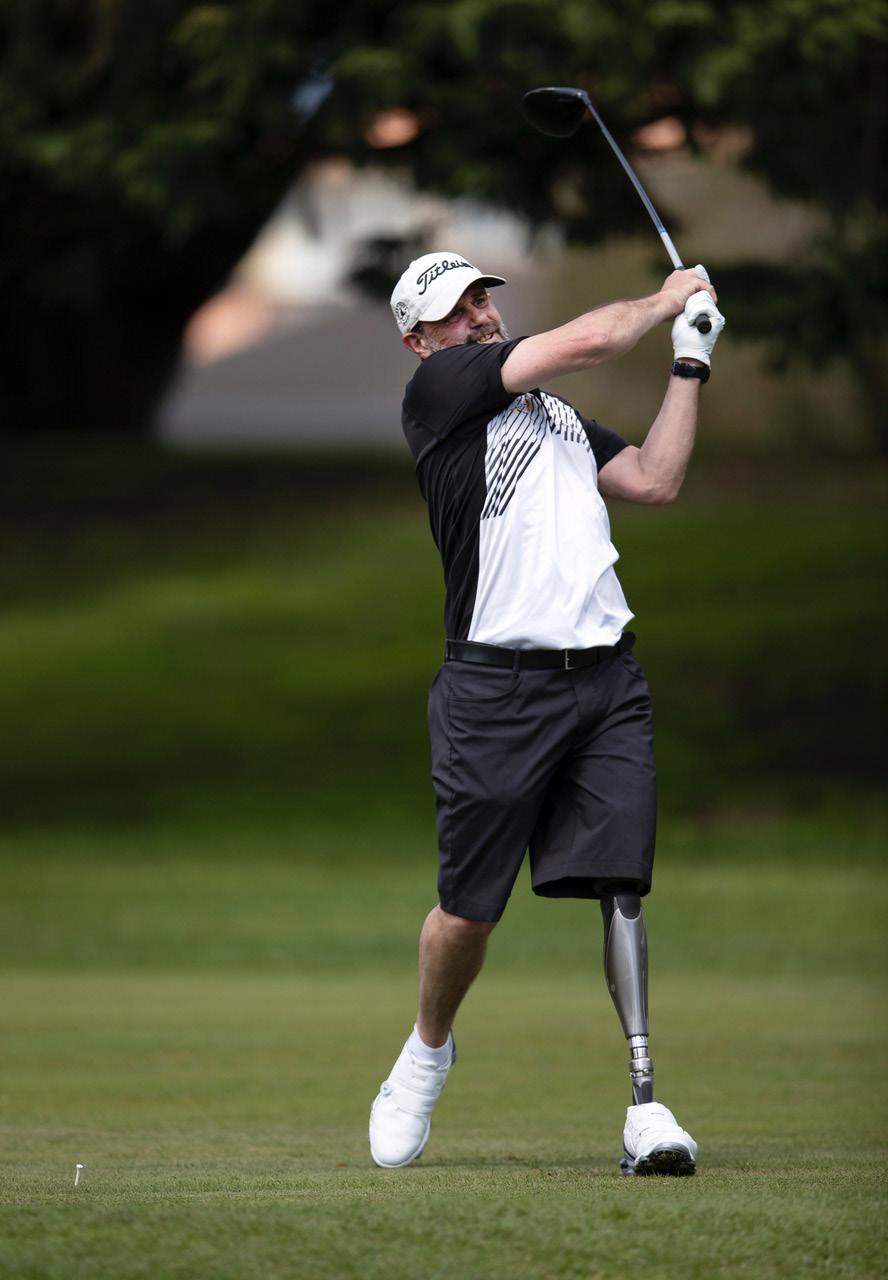

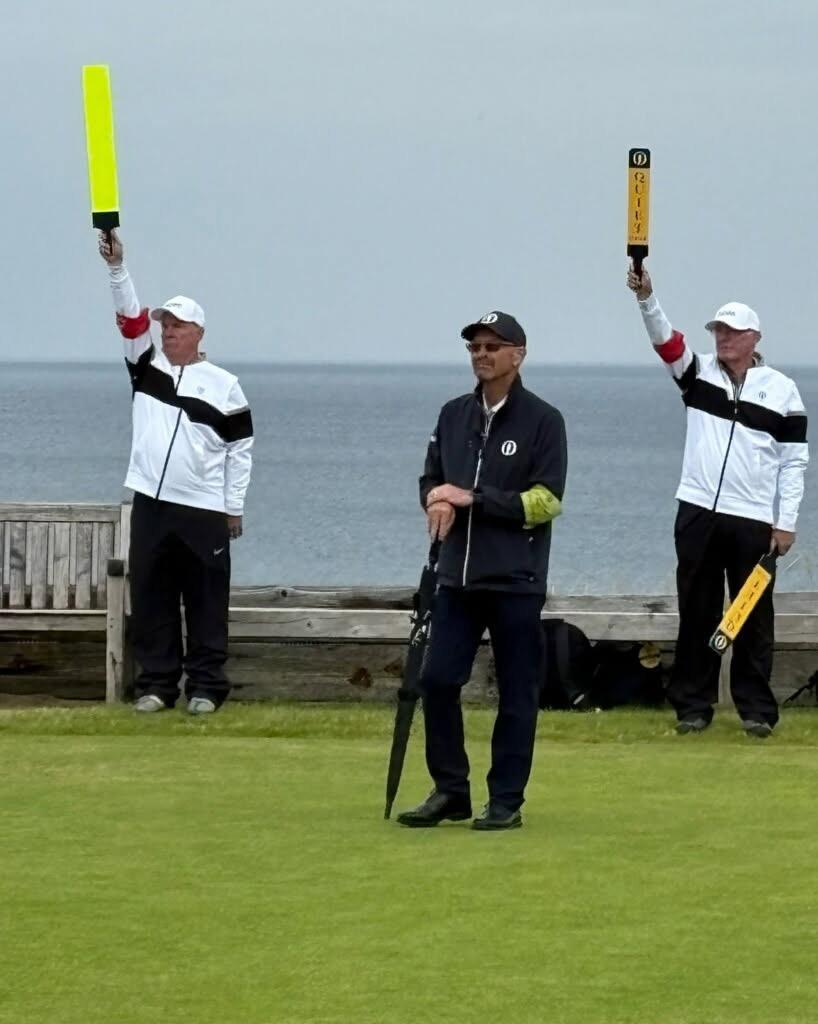
By Neville Idour
Phil Aickin is one of Golf New Zealand’s most experienced members having been the handicapping and golf services’ manager for many years.
It was fitting therefore that he should be invited to attend his third Open Championship in July as a walking referee. His first time was very special at St Andrews, Scotland, in 2010, then a year later he officiated at Royal St George in England.
However, this year, at the spectacular Royal Portrush in Northern Ireland, he rates as the best of them. Why?
Aickin replied: “The sea views out on the fifth, the sand dunes lining the fairways and the expanse of the property allows for an incredible experience for all. Add in the Irish hospitality and their love of the game, plus the enthusiastic support for Rory McIlroy and Shane Lowry and you have the best experience of the three.”
Aickin spoke about his Open experience at length with Golf NZ media and communications’ executive Will
Toogood and we are pleased to share much of it with Golfer Pacific readers. Having known Aickin for many years I have always found him happy to share his thoughts on any matters. Aickin has been much more than an administrator of course. His playing career was quite outstanding.
Aickin finished as top amateur at three consecutive New Zealand Opens. He represented New Zealand three times at the Eisenhower Trophy. He also banked an Australian Junior Amateur title. So he brings his experience and love for the game to his work off the course and when the opportunity arises, on the course, such as at the Open Championship.
He describes the feeling at Royal Portrush: “The atmosphere was electric. You go from the complete quiet respectful gallery as a shot is played to loud euphoria when a shot is holed or a putt drops. I was with Shane Lowry on the final day when he holed a seven iron and the crowd went crazy. His walk up the 18th was loud and long. The Open spectators are the most respectful and knowledgeable anywhere.”
For a rules official there is no lingering wake up time.
“Play started at 6.35am on the first two days, so for those officials with early groups it meant arriving at the course 60-90 minutes before their start time following a 40 minute bus ride from our accommodation.”
That meant a 4.30am or thereabouts start to the day.
“You then do all the necessary preparations with radio, paperwork, weather and meet the scorer, carry board volunteer and chief marshall for your group. Then it is on to the first tee arena.”
Aickin was very pleased to be with Ryan Fox on the first day.
“Foxy couldn’t get things going early in his round and was well over par but he played nicely over the last 12 holes. You could see why he is a two time winner on the PGA Tour this year with
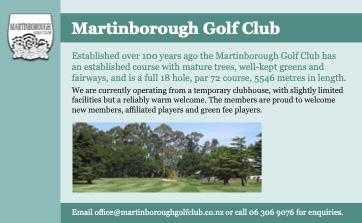
some impressive ball striking.
“He is now paired in marquee groups so it was nice to see Hideki Matsuyama and Matt Fitzpatrick up close. I was very impressed with Fitzpatrick who commented he couldn’t believe how quickly Fox played his opening shot of The Open.
“On day two I walked with Ryan Peake, Daniel Van Tonder and Phil Mickelson. Peake soaked up the experience and playing with Mickelson. The crowds love Mickelson who was all business. He talked through his options for every shot with his caddie at length, but once decided, he played quickly. At 55 he can still play, but openly made remarks about his preference for the logistics that surround LIV Golf events.”
So how busy was it for rulings to be made?
“Not too much happens at Royal Portrush from a rules perspective. There are no penalty areas in play, but out of bounds and extreme rough line the fairways. So the main rules required related to provisionals from the tee, ball searches, unplayables and relief from temporary immovable obstructions. I had nothing to report on for the first three days except to request a physio on Saturday.”
On the final day Aickin had to make two rulings for Jacob Skov Olesen. There wasn’t much chance to watch any golf apart from his groups.
“After our assignments on the first three days we either jumped on the return bus to the hotel or went to committee dining. It was time to chat with other officials and share stories.”
What did representing New Zealand on the rules team mean to Aickin?
“It was such a privilege to be part of the oldest and greatest major in golf. You meet the leading rules officials in the game and learn from them which helps me be better. I have so much respect for The R&A as keepers of our game and its goal to lift the calibre of officials throughout the world.”
Will his experience at The Open have
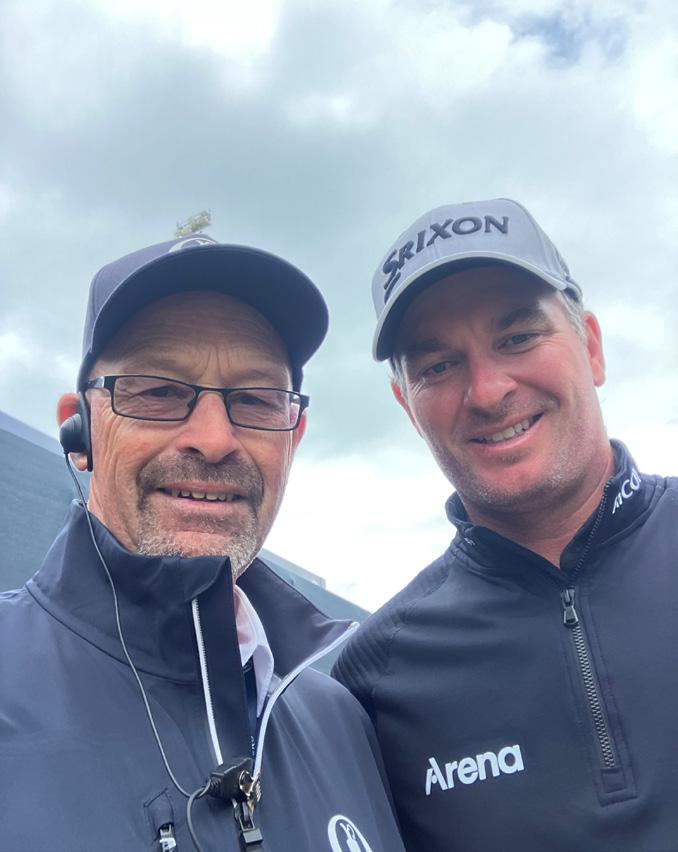
an influence on his work in New Zealand with handicapping and tournaments?
“My role includes the delivery and attendance at most of our elite events. It was beneficial seeing how they set the course up. Some in New Zealand may not like the tough pin positions, tight to the edge, only three feet from a slope or a pin on the same side of the green where the wind is coming from. The modern golfer with current equipment needs to be challenged and on our courses we need to set tougher pins. That’s one thing I will learn from that week.”
Finally, what did Aickin enjoy most about being involved in the prestigious Open Championship?
“I would love to have been good enough to play in The Open but that didn’t eventuate. But to be involved at Royal Portrush as a rules official, meet and work with the leaders in our game were real highlights. However sharing the experience with my wife Louise and seeing her excitement and joy at being part of The Open made it a week I’ll never forget.”


NBy Neville Idour
ow I know many golfer’s pride will not allow them to even consider what I am writing about here. It will be beneath their dignity because this is a golf club probably the most shunned, ignoring the simplicity it can provide because of that pride.
But hang on, I know you will never see a scratch golfer or professional with this chipper in their bag, simply because they don’t need one, as they have the ability to play without one successfully.
But what about Joe Blow, say an average golfer or higher handicapper? Could this chipper help them play more successfully from rough around the green? Well, I may be no coach but I can say the answer is definitely yes, from my experience.
It is not designed for playing over a bunker to the green but from the first cut of rough or where the ball is easily struck. It allows you to play a simple chip using a putting stroke,
thus avoiding complete chunking or sculling with, say, a lob or sand wedge. Some might watch someone using one with some amusement or derision, but when the “putt” ends up near the hole the laugh is on them.
It is very pertinent to note that two of golf’s biggest brand names Ping and Odyssey have added a chipper to their club ranges which has undoubtedly legitimised their use. The wide rounded sole and sufficient loft allows one to easily and effectively use your putting stroke from some way off the green without wrist break. It will cope far better than the putter negotiating the first cut of rough as the loft allows it to clear the rough nicely.
So if you can manage to putt without thinning or fatting then you should have no problem with this chipper — and we all know what happens when we flunk a wedge shot. The possibilities are not nice to contemplate.
So with most of the variables
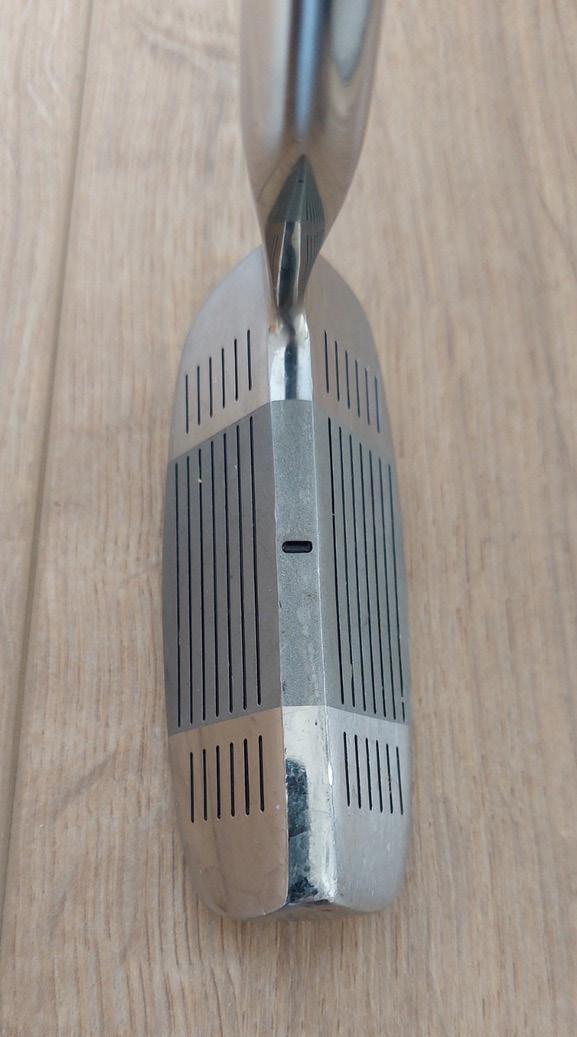
A two-sided chipper club that Golfer Pacific writer Neville Idour says he uses to great effect.
eliminated you can focus on line and pace as with a putt. Some might use a fairway wood or hybrid with some success, but these clubs are not designed

for those situations because of their longer shafts, whereas the chipper is designed for exactly these situations with the right shaft length and lie angle.
How often have we done it ourselves or watched our partners or opponents grab a lob wedge to play a chip shot from the rough within a few metres of the green and chunk it, leaving it in the rough or sculling it to the other side of the green or worse? Particularly, for the midrange and higher handicapper the KISS (keep it simple, stupid) method definitely has merit.
Maybe it is time to swallow one’s pride and give it a go. You might surprise yourself and have the last laugh on those who might consider you a laughing stock or to be sympathised with.
The scorecard does not record which clubs you used to prove you are a gun golfer. It only has spaces to record your score and stableford scores on each hole.
So why not take the risk of lowering your scores instantly by popping a chipper in the bag instead of a third or fourth
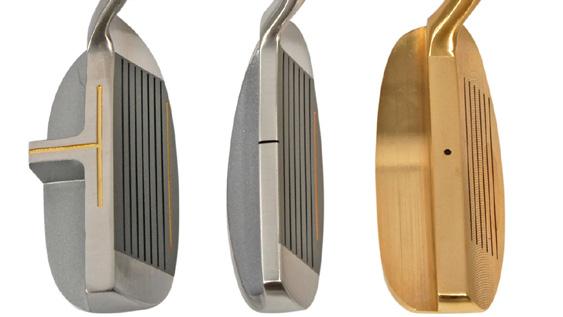
Three more examples of chipper clubs.
wedge? In fact I have done that with excellent results. But wait, there’s more. Have you ever been in a spot where you can not play a shot right handed or if you are a leftie, left handed?
The answer is waiting for you. I have a two sided PGM wedge in my bag. So I can play either a right or left handed shot as required from a tight spot. Maybe a tree or object is blocking your natural shot. This two sided chipper makes extrication possible in most situations. The good news is it doesn’t cost an arm and a leg.
So there you have it. To be chipper or not be chipper.
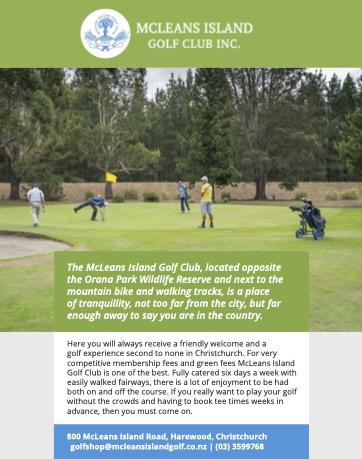
There are some things that just go together — like summertime and mini golf.
It’s the best time of the year to live in New Zealand and there is no better way to spend a hot summer’s afternoon with the family than a game of miniature golf followed by a round of ice creams.
Aotearoa is home to around 400 golf courses, but we also have a plethora of great mini golf courses in our main cities and in the regions.
The New Zealand Mini Golf Federation says there are 95 miniature golf courses across the country. From Kerikeri Mini Golf in the Far North to Jump N Fun in Invercargill, there is something for everyone across the summer months.
Whether it is whacking a ball through a windmill, navigating a narrow pass or weaving through a water hazard, mini golf appeals to that big kid in all of us. Playing a mini golf course for the first time is always a special experience. Here are 10 of the best at some of our favourite summer hotspots.
1. Queenstown Mini Golf
Located on the same street as the Skyline Luge and Gondola, and the Kiwi
Park, Queenstown Mini Golf is set in an idyllic location. On one side you look up to the see the gondola climbing up into the clouds, and on the other, the picturesque Remarkables mountain range as your backdrop. Our kids were in awe as they saw people parachuting down from above over the course. It’s a super fun layout and a great family activity in our tourism capital. If you put together a decent round here, you might even make it onto their global scoreboard. And if you make a hole-inone on the last hole you win another round.
www.queenstownminigolf.co.nz
2. Wild Wood Mini Golf, Whitianga
Is there a better place to spend your summer holidays than the Coromandel? Probably not, but I am a little bias. I grew up visiting Pauanui Beach every year – they have a great golf course there as well – and now every summer we stay at the Hahei campground. With Cathedral Cove just around the corner and one of New Zealand’s best beaches on your doorstep, it’s a magic spot. Just up the road is Whitianga which is a hive of activity in the summer months. The Wild Wood Mini
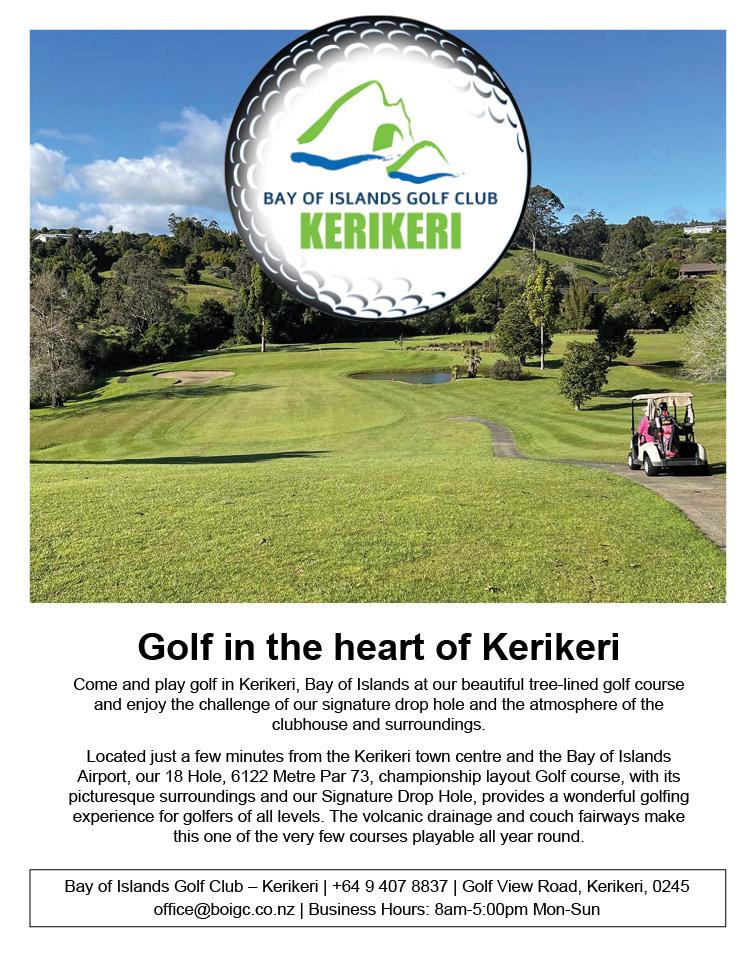
Golf is an awesome layout and a fun adventure for the whole family. It’s a cool setting. You will navigate 18 holes surrounded by lush gardens, banana trees, and water features. Across the Waikato there are a number of great courses like Callum Brae Family Golf & Café and Pro Drive (both Hamilton).
www.wildwoodminigolf.co.nz
3. Julian’s Berry Farm and Café, Whakatane
This place is a one stop shop for family activity. First, there is some of the best and biggest real fruit ice creams going around. Secondly, you can get all of the family out for a fun day of picking your own strawberries. Thirdly, there are cute animals on site and perhaps best of all is their miniature golf course. It’s a great challenge with plenty of tucked away holes, hazards and changes in elevation. We were here at the start of last summer, and it was warm and balmy. The sun always seems to be shining in the Eastern Bay of Plenty, and this is an afternoon well spent after time on the beautiful beaches at Ohope or Whakatane. www.juliansberryfarm.co.nz

4. Mini Golf, Rotorua
Just down the road from Rotorua’s famous gondola and luge, this is the most family friendly course in the country. You are welcomed by a host of Giant Flemish rabbits which roam the course. I am not a rabbit expert, but these have to be the softest and fluffiest bunnies you will ever come across. They also have Cactus the Rainbow Parakeet to add to the chaos. The layout is quality as well. It comes alive at night with a thousand fairy lights creating a unique atmosphere. Completing a round of mini golf can be challenging with young kids and even more so when all they want to do is chase the bunnies. It’s an experience that will live long in the memory. The
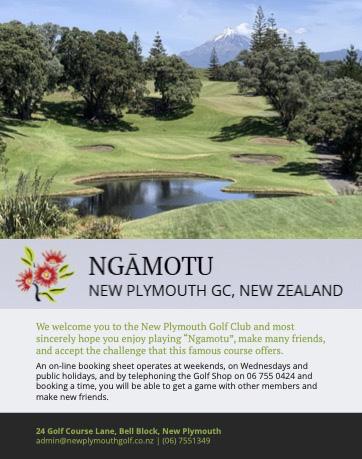
best hole is No. 13 (affectionately called the ‘Love Hole’ as couples pose for selfies here with the fairy lights as a backdrop). www.facebook.com/MiniGolfRotorua/

5. Treasure Island, Auckland
This has to be one of the busiest mini golf courses in the country. It’s not a summer hotspot but it’s a popular venue for locals and many people visit Treasure Island when they have some time to kill before catching a flight. It’s just down the road from Auckland Airport. It’s a lot of fun and our family’s favourite. My fouryear-old Toby asks most weekends if we can go back to this place. Treasure Island includes two great 18-hole courses -Blackbeard’s and Captain’s. It offers quality family entertainment, and it is suitable for all ages. You’ll putt through Pirate Ships, over waterfalls, around sharks, crocodile and eel infested waters and hear the cannon blast. It’s a great challenge and one that you’ll want to come back to, to try again. There is also their sister property Pirate’s Cove in Porirua, Wellington which is also awesome. www.adventuregolf.co.nz
6. Par 2 Mini Golf, Napier
It’s hard not to love this part of Aotearoa. There aren’t many places better to enjoy your summer holidays than the sunny Hawke’s Bay. Located on Marine Parade in the heart of town is Par 2 Mini Golf where you can spend plenty of
quality time. There are two great courses that are designed for fun and for those super competitive family battles. The layout boasts panoramic views of the Hawke’s Bay and the Pacific Ocean and is alongside Napier’s wonderful Art Deco architecture. “Pacific Pro-Am” is a traditional putting game where professionals and amateurs can play alongside each other. While “Deco Drive” has longer and more complex tests that reward putting skills.
www.par2golf.co.nz
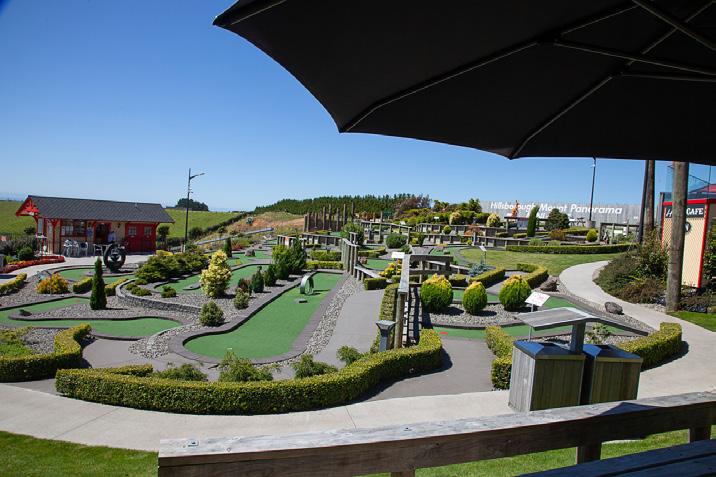
Taranaki is a special spot for a break and enjoyable in all seasons. I used to come to ‘Tara-dise’ once a year for the Taranaki Open on the Charles Tour and it was always one of the better weeks of the year. The rugged beauty of the west coast, the great golf courses and the friendly locals. It’s also home to one of the best little mini golf courses in the country. This is one for the petrol heads. You will test your golf skills on a course where the layout is based on the famous Mount Panorama track at Bathurst. It’s pretty much brand new and in great condition and onsite there is the Hideaway Café. You can add to the experience by visiting the Hillsborough Holden Museum and enjoying the Hideaway Luge. www.hillsboroughholdenmuseum. co.nz/minigolf


Smallgusta mini putt in Tauranga.
The Bay of Plenty is one of New Zealand’s favourite summer destinations. When you stay at Mount Maunganui, there are beautiful beaches everywhere you look and the place has a special vibe. This place is making a name for itself – if you close your eyes, you can almost hear that unforgettable theme tune from The Masters. The mini golf course ‘Smallgusta’ is a play on the famed name of Augusta National and is New Zealand’s first 1:10 scale course. It has become a destination with the Ōropi Hot Pools, licensed café and you can even stay on site in the four-bedroom house. It would be a super fun break with some good mates. www. smallgusta.co.nz
One of the newest and perhaps most innovative mini golf courses in the country. Swingers has made quite the impression since opening three years ago. On a warm sunny afternoon, there aren’t many places better than having a quiet pint on The Landing deck surrounded by an artificial wonderland. Like the Turangi course, the layout highlights many of the attractions of the local tourism landscape. You’ll putt up and over Mt Ruapehu – complete with mini skiers on the mountain and on a chairlift, over the iconic Huka Falls, alongside Lake Taupō and down Desert Road, and many more features. The attention to detail is incredible. If you are coming to the Central Pla-
teau this summer, it is a place you have to experience for yourself. One of the best holes on the course is Mount Doom which has a big dragon that roars above your head.
www.swingersputtputt.co.nz
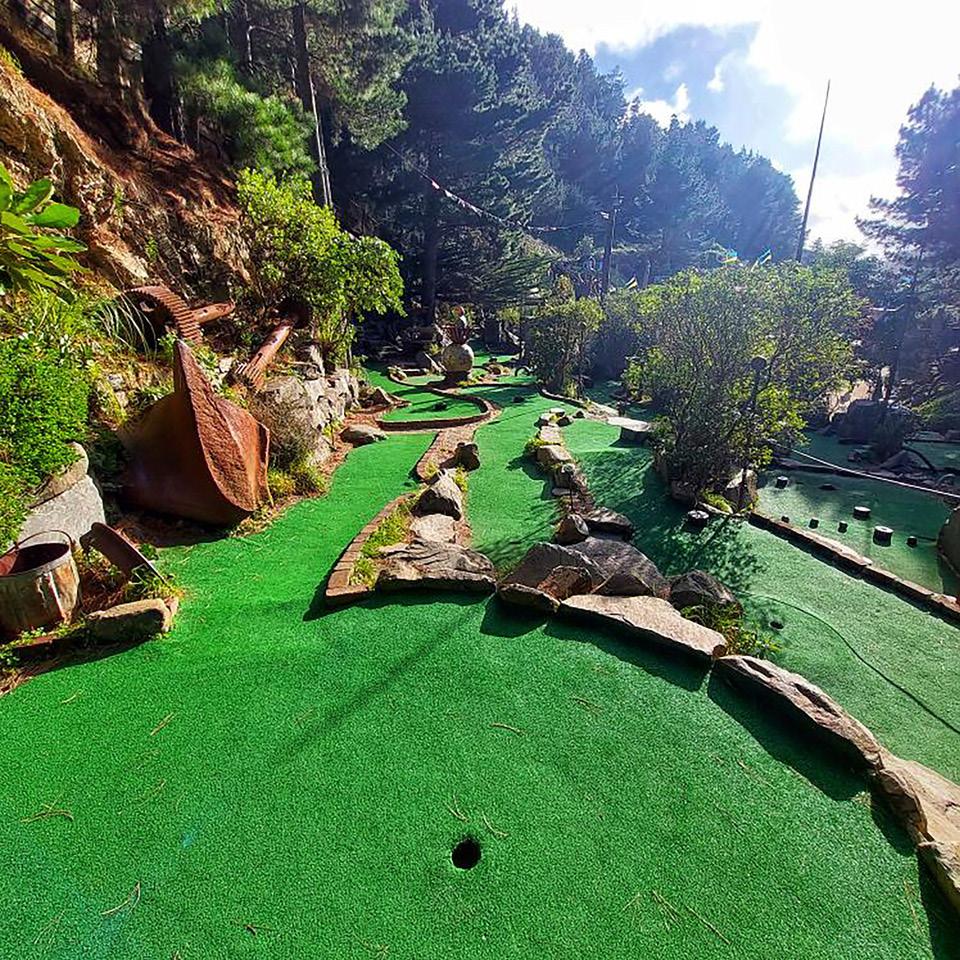
10. Carlucci Land Mini Golf, Wellington
Up amongst the hills of Happy Valley near Ōwhiro Bay is a magical wonderland that is one man’s vision. They say one man’s trash is another man’s treasure. Carl Gifford’s passion for recycling materials and making unique sculptures from metal and rock set the scene for Carlucci Land. Inspired by the rugged Ōwhiro Bay coastline, Gifford developed a love for his environment. By making a mini golf course from recycled materials he combined his love for adventure and art. “It’s a little rough around the edges, but it’s all part of the theme,” Gifford says. The course has plenty of character and quality about it. And the constant is Gifford’s imagination. You putt through contraptions and home-made rails and come across the many rustic sculptures throughout your round.
www.carlucciland.nz
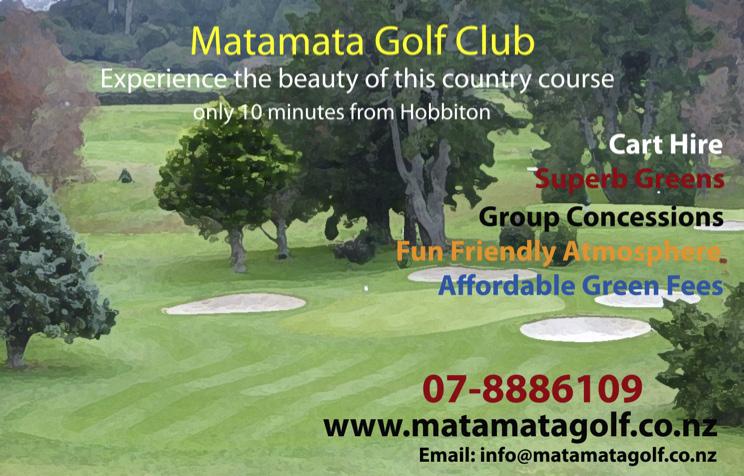
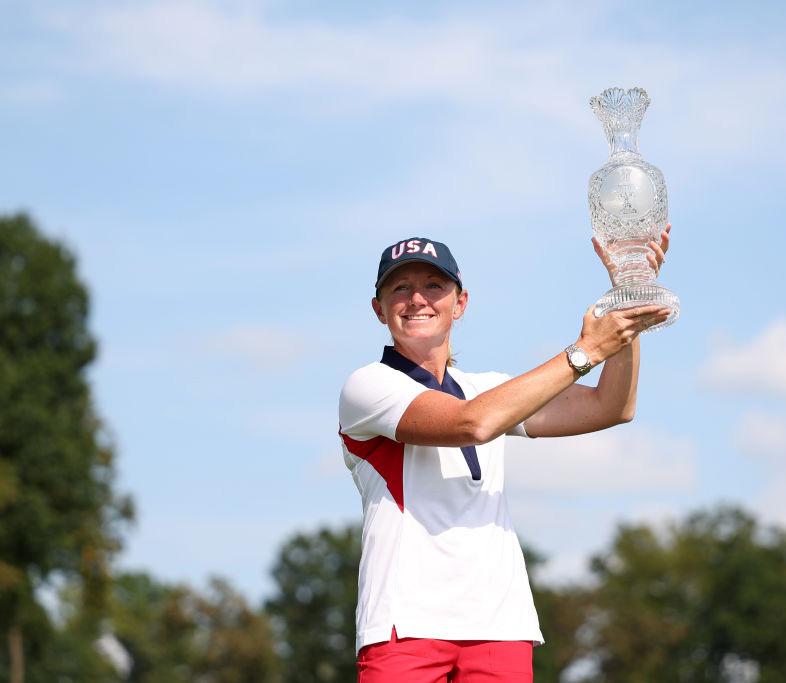
By Neville Idour
American golfer Stacy Lewis, a two time major championship winner, has announced on social media she will retire from the LPGA Tour at the end of the 2025 season thus bringing an end to a distinguished and outstanding career. Lewis was ranked world number one for various periods during 2013 and 2014.
She is only one of three players to win the Women’s Open at St Andrews in Scotland which she accomplished in 2013, after winning her other major, the Kraft Nabisco Championship in 2011.
She was a remarkable and gritty youngster as she was diagnosed with scoliosis (a condition in which there is a side to side curve of the spine) at age 11. Then she was treated with a spinal fusion while in high school and missed her first collegiate golf season recovering from that surgery.
Lewis said on social media: “Never in a million years would I have thought this journey playing golf would still be going in 2025 but the time has come to put the clubs away. I will finish the 2025 season but this will be my last on the LPGA Tour.
“I’m not exactly sure what is next, but I’m going to miss the LPGA Tour family, which is part of my life, but my body has told me it’s time. My husband became part of the team, fitting in seamlessly providing great balance and stability to my life. I’m looking forward to having more time as a family.”
Lewis was born February 16, 1985, in Toledo, Ohio, and grew up in Texas. Her amateur career was sprinkled with highlights and many victories. In 2007 she was selected as Golf Digest amateur of the year and finished second individual in leading the US team to victory at the Copa de las Americas.
In 2008, as a member of the US Curtis Cup team, Lewis became the first player ever to go 5-0 in a single Curtis Cup. This was her last competition as an amateur and appropriately it was held at the Old Course St Andrews and was won 13-7 by her US team.

She turned professional following this victory and finished tied third in her first event behind winner Inbee Park, having led after the third round. She competed in seven LPGA Tour events in 2008 with two top 10 finishes. Her first official professional victory came at the 2011 Kraft Nabisco Major, where she held off world number one Yani Tseng, to win by three strokes. In 2012 she was the first American player to win the LPGA player of the year award since 1994, then repeated the dose two years later.
Over the years she has fashioned a fine record and with 11 LPGA Tour wins and the two major championships. She has captained the US Solheim Cup team in 2023 and 2024, as well as playing in it four times. Her husband Gerrod Chadwell has himself been golf head coach of a Texas women’s team since 2021.
They have one child and it was quite delightful to see six-year-old daughter Chesnee happily dancing along the fairway with mum Stacy at a recent LPGA Tour event.
Lewis has been a class act in women’s golf ever since she made her mark as an amateur and will be missed. Typical of her class and loyalty is her caddie of 17 years, Travis Wilson. She is so thankful to all who have supported her through the years.
She signs off with some heartfelt thoughts.
“I have cared for the LPGA Tour as if it was my own child and I am very proud of the progress we have made. However to my fellow players, we aren’t done yet. I hope you will all continue to push the tour forward and do all you can to help both on and off course.”
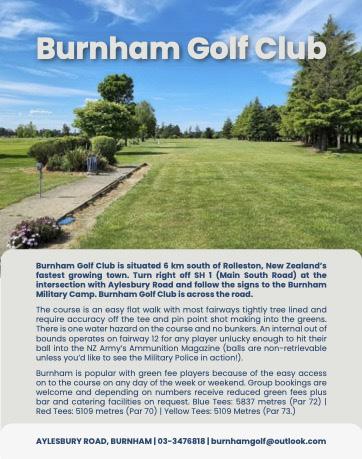

By Neville Idour
When the rules were changed in 2019 by The R&A and the United States Golf Association to allow players to putt with the flag in, no one could have predicted the entrenched attitudes that would prevail.
Personally I have loved the freedom to get to the green first on occasions and line up a putt and sometimes putt out before anyone else is ready to putt. It is so convenient in a casual round not having to fluff around taking the flag out.
But I digress. Back to the question. Statistically is there more chance of holing putts with the flag in or out? Well to those golfers who always want the flag out the findings are quite decisive and not in their favour. My Golf Spy, considered the golf industry’s leading independent testing and review platform, have un-
dertaken extensive testing of putts from a variety of distances, with the flag leaning back and forward, with rigid and less rigid flagsticks, plus centre and off centre strikes have come up with quite conclusive results.
A putting machine called the perfect putter was used. Each test was run at three different speeds where the ball would run three, six or nine feet past the hole. The make and miss perentage from all putts and distances was recorded as well as the distance of missed putts.
The end result after all the testing was “leaving the flagstick in” is ALWAYS an advantage versus taking the flagstick out. Now we will go into more detail as to why. Flagstick in keeps the ball closer to the hole on misses. A less rigid flagstick has the highest make percentage and least distance from a miss. Even the most rigid flagstick in is still an ad-
vantage for makes and misses over flagstick out.
Dead centre strikes provided the best make percentage and left the shortest distance to the hole on misses. Off centre strikes on the flagstick also provided a higher make percentage. Even with the flagstick leaning toward the player it is still an advantage to leave it in. Depending on how strong the wind is this is the only time I might take the flag out.
Putting guru Dave Pelz put it very succinctly when he said: “The science proves you should leave the flagstick in when you putt.”
He also mentioned the rule change was a major move to speed up play. Golf Magazine published the results of a pin in/pin out test in 1990. Again the results were conclusive.
“You will hole a higher percentage of putts when you leave the flagstick in.”
So in 35 years nothing has changed.

Matt Fitzpatrick is one high ranking tour player who always putts with the flagstick in. His world ranking has improved since he made the change. He said he feels more comfortable and the flag in narrows his focus. His results are eye opening. He was 60th for putting average in 201819 with the pin out. Four years later he was 43rd with the pin in. As for number of putts per round he improved from 77th to 16th, while his one putt percentage improved from 53rd to 35th.
So the question is will these conclusive facts move the needle for any flagstick in entrenched advocates? From my experiences with golfers of all types there are many who simply won’t depart from the tedious tradition of flagstick out even on tap ins.
Of course, as mentioned earlier, the rule change was also intended to speed up play. Unfortunately when you
are in a group and some want it out it becomes quite tedious and frustrating having to ask for the flag to be put back in when your partners know you like it in and vice versa.
So the intention to speed up play is hampered by this continuous scenario. However on the other hand, if you are in a group or just a twosome where all putt with the flag in it is simply wonderful and the time spent on the greens is reduced considerably. The game flows nicely. If all golfers could putt with the flag in the time spent on an 18 hole round could be cut by 20 minutes or more.
Maybe that is too much to hope for, or is it? Don’t let tradition get in the way of shooting lower scores. The facts speak for themselves. Putt with the flag in. Try it, you might enjoy it. It is only a small step for golfers but in the scheme of things it is one huge step for the game.


By Neville Idour
verseas media criticism of the PGA Tour and suggestions of how to strengthen and improve it raised many pertinent thoughts.
Obviously, leading the way was to bring back many of the games best players and biggest drawcards such as Bryson DeChambeau, Jon Rahm, Brooks Koepka, Cameron Smith, Joaquin Niemann, the polarising Patrick Reed and several other leading LIV players.
New chief executive Brian Rolapp said he was “interested in exploring whatever strengthens the PGA Tour.”
How he can get these players back in the mix, or if it is even possible, remains to be seen. At this stage any deal between the PGA Tour and the LIV is nowhere to be seen. So what are some of the issues that the PGA Tour needs to deal with?
Firstly sort out the disparity in the schedule which some feel is far too long. We now have full field events, the limited field signature events with no cut plus those tournaments now that rarely feature any top 50 ranked players, or in some cases many top 100.
Television ratings are affected as is prize money, all impinging on loyal sponsors. The schedule needs to be streamlined with some lesser events elevated
or removed to the second tier Korn Ferry Tour. All these things affect the rank and file players and sponsors.
Secondly the signature events are having a dubious effect with their limited fields. Players earn their place on the PGA Tour with a tour card. Why should they be excluded from a significant number of regular tour events.
Rolapp has already extolled the strength of the players and the “anyone can win” mantra. So if a player has his card he should be able to play in every regular tour event, signature or otherwise. If it is so important to have stronger fields, cut the number of PGA Tour cards per event to 100. Also bring back a cut in every event.
Next, pace of play is a killer for viewer interest and it was ironic it took a woman’s comments during the Farmers Insurance Open that went viral to spur some action. Dottie Pepper said on the broadcast: “I think we’re starting to need a new word to talk about this pace of play issue, and it’s respect … for your fellow competitors, the fans, for broadcasters, for all of it. It’s just gotta get better.”
Six-hour rounds on a Sunday on a difficult course when the wind gets up are simply not on. Slow play is like a never ending nightmare and a big turnoff for all. The television coverage also comes under the spotlight. Viewers just want to see

more shots, fewer commercials and some interaction between players and their caddies when lining up their shots. So maybe it is time to mic up players and caddies.
Particularly might this apply to those in contention playing the final two holes of an event. Showing more shots from more players is a definite work on. Too much of glacial dinosaurs like Patrick Cantlay or Keegan Bradley or others of their ilk preparing for their shots would send anyone to sleep. Plus we don’t need to see players walking at some length from A to B or too many players who are way outside the cut line. The tour needs to study and adopt some of LIV golfs coverage as they will show as much as 50 per cent more shots at any given time.
The next one is purely a US college gripe. College stars should be allowed to move straight on to the tour if they are good enough. Luke Clanton had success while still at college and Nick Dunlap won the AmEx last year as an amateur. Ludvig Aberg and Jon Rahm came straight from college and were immediately competitive. Perhaps up to five each year could be allowed to move up.
Let’s play on better courses is another criticism. Some say there are too many tree lined parkland courses. Surely in a country as vast as the USA the tour can find some linksy courses or Pebble Beach type courses that create interest. Think
New Zealand and what Christchurch Golf Club produced at Shirley Links and the remarkable Tieke golf course near Hamilton. Find courses like these.
Finally, are the FedEx Cup playoffs past their use by date? Yes I say. It is supposed to be the greatest win for a PGA Tour player. It doesn’t feel like it. The playoffs are a farce. What are they trying to achieve? Of course they are trying to create a grand finale of excitement and entertainment. But who needs it? Not the players or the fans. So what to do?
Why not, for the last two or three events, allocate extra points with perhaps double points for the final one. Then there would be real pressure on performing well, especially for the points leaders.
Ultimately though the season-long points leader would get his just reward as Scottie Scheffler should if he sees out 2025 on top. If some extra finale is needed perhaps have a 32 man matchplay event. But really what’s the point? No, the time has come for the PGA Tour to grow up and get back to its core roots and stop trying to eliminate its perceived opposition, LIV Golf and the DP World Tour which it has harmed hugely in recent years. Perhaps Rolapp can redress the damage done during Jay Monahan’s reign.

New committee for PGA Tour
New PGA Tour chief executive Brian Rolapp has announced the creation of a new committee to be chaired by Tiger Woods. The committee will comprise of six players, including Woods, plus three business leaders to influence future PGA Tour decisions.
Their task will include improving and developing a new future competition model, as well as having a heavy influence on general tour business. Patrick Cantlay, Adam Scott, Camilo Villegas, Maverick McNeally and Keith Mitchell will join Woods. The committee will have three guiding principles. First is competitive parity.
“Anyone on tour who is a good enough golfer should have a shot at winning.”
Second is scarcity. A focus on the tour’s top players to compete together more often in events that feel special for the players and the fans.
The third principle is simplicity, whereby competition should be easy to follow and build towards a tour championship in a way that all fans can understand.
James Hahn unhappy
Veteran PGA Tour player James Hahn is unhappy with the addition of another signature event to be played at Donald Trump’s Doral golf course.
The Miami Championship, a ninth signature $US20 million event, will end a decade long absence from Trump owned courses for the PGA Tour. Hahn is frustrated that the tour is offering fewer opportunities to rank and file players by this move.
The 43-year-old unloaded his anger saying: “An extra signature event without a title sponsor at a course owned by the president. This is a joke, right?”
Hahn has simply had enough of the PGA Tour’s top heavy business model.
Robert Garrigus was also not pleased with how sponsor invites work.
“So does that mean one more sponsor invite for Jordan Spieth? Tell Spieth I’ll play him for any amount and if I win I get his five invites to the signature events. As an example the player impact programme (PIP) we gave out $US30 million the first year, $US50m the next and $US100m after that. That all came out of the tour’s reserves. We have effectively given away $US200 million in three years when at the time we had $US230m in reserve. This is not sour grapes, I’m talking about our business being sustainable. The PIP was the biggest joke.”
Monty was a Ryder Cup star Europe enjoyed a purple patch in the Ryder Cup between 1995 and 2006 and durable Scotsman Colin Montgomerie was right in the forefront of the action. He is the joint fourth highest points
scorer in the event’s history with 23.5 points in his five matches. He was unbeaten in singles and this made him one of the most feared opponents on Ryder Cup Sunday. Why? Because he loved getting inside people’s heads.
“It’s chalk and cheese compared to strokeplay,’’ Montgomerie said.
“You have just one guy to look at and figure out. Doesn’t matter what you score. You just have to beat him. You see a score of 4 & 3. Yet he could have shot 80. A lot of people play the course in matchplay. I never did. I played the man, whoever it was and it worked out okay. I hated defeat more than I loved winning and that was my key in Ryder Cups. “
Monty was accurate in his predictions and warnings about the just completed clash. He had no doubt it would be carnage in New York at Bethpage.
“They have got to silence that American crowd as soon as possible. It will be boisterous. It will be game on, a bit like Boston in 1999. I hope it doesn’t go overboard in that way.”
Monty was right on the money.
Daly up to his old tricks
John Daly has made the headlines for all the wrong reasons again, after years of relative quiet. This time he was playing in the Sanford International on the Champions Tour (for over 50-year-olds) and in the first round he was three over par after nine, bogeyed the 10th and parred 11. Then on the par five 12th it all fell apart.
It is unclear how he managed a 14 over par 19 as there was no shot link system. What we know is the tee shot found the primary rough and following that seven penalty shots resulted before the 59-year-old holed out. It was the highest hole score in Champions Tour history. He did manage a birdie and a bogey over the remaining six holes.
His 19 surpassed his previous highest score on one hole dating back to 1998 at the Bay Hill Invitational when he shot 18 on the par five sixth hole. He hit a 3 wood into the water six straight times.
Greg Norman has called time on his tenure as chief executive of LIV Golf after four years getting the tour off the ground and established.
“After four unforgettable years, I have officially closed out my time with LIV Golf, reflecting with nothing but gratitude, pride and achievement.
“Together we built a movement that changed the game globally. We truly globalised the game and expanded golf’s reach to fans around the world. Thank you to everyone who has been part of the journey with me. As for
what’s next, stay tuned. Exciting times ahead.”
Even Rory McIlroy, a vocal critic in the past, had some kudos for Norman.
Said McIlroy: “Greg took a lot of flak the first couple of years, but he is probably one of the only guys in golf who could have taken on that role. He got it off the ground and you have to commend him for that.”
The 2026 New Zealand Hickory Open event will take place again at Christchurch Golf Club from 28th January 28-February 1 on a Sir Bob Charles designed hickory layout with a 5200 metre men’s course and 4800 metre Women’s course. There will be four divisions — open championship, seniors (60 plus), reserves (45 plus) and women’s.
Sir Bob intends to play and already there is strong interest from across New Zealand and 10 Australians confirmed. A South Korean team is also expected to enter.
The event concludes on the Sunday with the 18 hole singles championship followed by an evening prize giving and celebration dinner for players and partners.
The Challenger PGA Tour of Australasia will offer almost $A7million across 10 events in the first half of the season leading up to December. The Australian PGA Championship at Royal Queensland is up $A500,000 to $A2.5 million, while the Australian Open will offer a minimum of $A2 million. Three DP World Tour cards will be up for grabs.
One of the highlights will be the appearance of Rory McIlroy at the Australian Open at Royal Melbourne. Ryan Fox will also be one of the headliners in Australia.
On the tee box you can only use reference points that already exist when lining up your ball placement. So no dropping an alignment stick.
Jack Nicklaus picked a reference point no more than a club’s length away, just so you can see it with your lead eye. Nicklaus did this for years picking a small spot on the ground a few feet in front of his ball on the target line. Don’t put your tee in the ground first.
So to do this properly you find the spot first, then put your tee in the ground in line. Then to help the process you can align your feet to this imaginary line between tee and reference point. Voila, we are ready to launch. I have been doing it this way forever and it works. Thanks Jack.
Cameron Smith determined to recover
Aussie Cameron Smith is the first to admit his results in 2025 have not been up to scratch. Missing the cut in all four majors was a shock to the system. After all he has top 10s in all four, top fives in three of them, a runner up at The Masters and of course that wonderful win at the 150th Open at St Andrews in Scotland when he shot a final round 64 to beat Rory McIlroy.
“My motivation is high to get back to where I was,’’ Smith said.
His driving is longer than at any time in his career and he is working hard on his short game and looking forward to another career purple patch. Keep in mind there have been some challenges this year. He became a father just two weeks before his early exit from The Masters. Then his grandmother died in June and he had to return to Brisbane for the funeral. Not ideal preparation for the US Open. He hates excuses but life’s experiences are important factors.
A time to speak and a time not to
Pablo Larrazabal is one player who was frustrated with missing out on the Ryder Cup side and the qualification process.
A nine time European Tour winner he has never featured in the Ryder Cup. He took to social media saying: “Again it goes with what captain Luke (Donald) thinks is the best team. Zero players that play the European Tour schedule so what’s the point? Marco Penge deserved a pick and Matt Wallace deserved a pick, but only 12 men play. Good luck in NJ. (It’s in New York Pablo).
He subsequently appeared to poke fun at Donald suggesting he picked his six partly because they had previous Ryder Cup experience and expected that would be vital in dealing with the hostile American crowd.
“If you want experience in the RC why are you not taking Miguel Angel Jiminez who won four times this year and is not going to miss a shot.” Fellow Spaniard Jiminez is of course playing on the Champions Tour. Are you really serious Pablo? You said it all yourself. Donald’s reasoning for his selections were stunningly on the money. Yes Pablo, as you might well reflect: There is a time to speak and a time to keep quiet.
The good, the bad and the ugly that was the Ryder Cup at Bethpage will be looked at in some depth in the November issue when all the dust has settled. There was simply no chance to meet the deadline for this issue.


The inaugural Jakarta International Championship has been confirmed by the Asian Tour – adding an exciting new event to its schedule
that will contribute further to a gripping end to the season.
The tournament will boast prize money of $US2 million, making it Indonesia’s most lucrative golf tournament and enhancing the nation’s reputation for being a strong supporter of professional golf in the region.
The Jakarta International Championship will be played at Damai Indah Golf from October 2-5 and will be the 13th event of the season on the Asian Tour.
In addition, it will be part of The International Series – 10 upper-tier events on the Asian Tour that offer a direct pathway to the LIV Golf League. It is the fifth stop of the year on the series.
The government of Jakarta has lent
its support to the tournament, which will mark the Asian Tour’s second visit of the season to Indonesia.
The government is confident the collaboration will help promote Jakarta as a global city while providing an opportunity for local players to compete at the highest level.
Cho Minn Thant, commissioner & chief executive of the Asian Tour, said: “Jakarta has been a popular and regular destination for the Asian Tour for decades, so staging the Jakarta International Championship has great meaning to us.
“It is going to be an incredible addition to our schedule, not only bringing something new to our line-up but also adding importance in terms of a lucra-
tive purse, outstanding golf course and place on The International Series.”
Rahul Singh, head of The International Series, said: “Jakarta is the perfect launch-pad as we prepare for a thrilling conclusion to the season. This tournament, which kick-starts the second half of the campaign, will go a long way to deciding who wins The International Series Rankings race and earns a spot on the LIV Golf League next season.
“The Jakarta International Championship is another milestone moment in a successful season which is taking us to new markets and established destinations, once more showcasing the strength of The International Series brand.”

DBy Neville Idour
oes your golf club encourage mixed and inclusive golf?
Is the clubhouse a welcoming place at all times for both men and women plus younger ones when there is no particular function or tournament in progress?
Or is your club still stuck in the “gentlemen only, ladies forbidden” golf syndrome?
Do your club tournaments or club days encourage all members to enter by generally allowing play from more than one tee? Thus utilising the benefits of the handicap system.
That has always been one of golf’s greatest assets. No matter a player’s handicap they can compete on an even playing field. My home club has a monthly member event open to visitors but it only allows the
men to play from the blue tees. I played in it once but found I cannot reach the fairway with a playable shot on a couple of holes.
The 17th in particular I cannot clear a hazard and had a choice, lose a ball in the hazard and drop another one to play three or chip my ball to a forward tee. Not as easy as it sounds.
So I, along with I’m sure other male members, don’t play the event and although I am shorter from the tee I am certainly not the shortest player from the tee. I raised this with the pro shop staff and got a gruff “all the men want to play from the blue tees.”
End of story. For a regular club event, that is not inclusive, it is exclusive.
Now I am aware and not against a specific open event that is a challenge. Some years ago, in my younger days Ter-
race Downs in Canterbury ran a monthly black tee challenge which morphed into a blue tee challenge which I enjoyed playing, when I could hit my tee shots a little further. This event was never conceived as an all inclusive member event as Terrace Downs was not a typical member golf club back then.
Thankfully gender barriers to “prestigious” golf clubhouses are a thing of the past here in New Zealand, although United States golf journalist Carly Cummins said not that long ago she was refused entry to a top 100 USA golf course clubhouse for being a woman.
However, it is still very common when it comes to competition club days in New Zealand for segregation. For women it may be Tuesday morning and for men Wednesday morning.

Then on Saturdays in the past it was men’s reserve as a throwback to the days when men worked and women stayed at home.
But, is there any reason why club days could not be open to both men and women? There would be three days a week for members, male and female, to play in a competition. There could still be separate comps for each and those blokes who want to play with blokes and women with women could still do so, as well as those who were happy to mix it up.
Perhaps this may be something of a hurdle for our large membership major clubs to come to terms with but not so much for smaller clubs. I have experienced clubs that encourage both men and women on club days and the atmosphere is
very social. The culture of a club can only improve and develop with this inclusive approach, and be more appealing to the younger generation.
With more working women today it is vital to give them every opportunity to enjoy weekend play. Of course some women can be intimidated playing with a group of men so these things need to be catered for in a mixed environment. However view it as an opportunity to broaden the horizons and you might enjoy it. Most men enjoy encouraging the fairer sex. So seize the day ladies.
Clubs need to embrace and encourage mixed golf at every opportunity. We want all to feel welcome and included in their golf club at all times. The days of outdated stuffy rules should be long gone.

By Neville Idour
We all know how rare scoring a hole in one is.
It matters not if you are a higher handicap amateur who hasn’t been playing for very long, or a seasoned professional. Holes in one don’t grow on trees. Just to show how crazy scoring a hole in one can be I will share some statistics.
How many would you think the great Seve Ballesteros would have scored. Would you believe zilch, not even one. Then I think of my wife who only took up the game in her 40s and soon became a useful golfer reaching a single figure handicap some years ago. Although she
hasn’t had an ace for some years she racked up an impressive five in her earlier days as a golfer. It is quite ridiculous to ponder my own two holes in one as, at best, I briefly achieved an 18 handicap. It is almost an insult to Seve.
Anyway, now to a remarkable achievement at East Herts Golf Club in England. We have heard of players making consecutive holes in one, but amateur Pete Sawyer blew it all away. For the average golfer the odds of making one hole in one are 12,000-1.
Sawyer, who has only been playing seriously for seven years has made four, three of which were scored in the last three months. Hence the odds of 1.19 trillion to one in the headline of this article.
he Hong Kong Golf Club (HKGC) will return to the global spotlight this month when it stages the Hong Kong Open.
To be conducted over the composite course at the fabled Fanling venue from October 30 to November 2, further lustre has been added to one of the region’s most prominent tournaments with the winner being granted exemption into the Masters Tournament in the United States and The Open Championship in England in 2026.
HKGC captain Andy Kwok said: “We are all set for four magnificent days of action, as the historic Hong Kong
“All my luck has come at once,” said Sawyer who started as an 18 handicapper and has improved to his current 3.1. He plays a lot with his brother-in-law Chris Edwards who is a PGA professional and a caddie for Gemma Dryburgh on the LPGA Tour. Sawyer said he feels a bit guilty. Chris hits the ball so well and on every par three he hits it close. But he’s never made one. Incredible. Sawyer certainly plays in good company.
His first hole in one came at the 18th at East Herts in May, 2024. It was a 173-metre five iron which he nailed, to the delight of the full balcony of members watching it all unfold. To top it off it sealed his lowest ever score of 73. Almost a year later to the day
Open continues to grow in prestige on the international stage.
“To be selected as one of only a handful of pathway events reflects the rich heritage of our club and the 65-year-old championship, but also Fanling’s global reputation as one of golf’s foremost tournament venues.
“We very much look forward to seeing the fans come out in force to support our Hong Kong players and watch some of the most exciting players in the game.”
Among the favourites will be defending champi-

he aced a nine iron from 138 metres on the 15th on the way to a new lowest score of 70. The following month he flushed a four iron on the 14th at Welwyn Garden City. The best was yet to come. In August, on captain’s day, at Woburn he flushed his first shot, a six iron from 176 metres which rattled its way into the cup. Sawyer enjoyed all the congratulations from the large numbers on course. Of course this all added up to expensive bar tabs, but that was all part of the celebrations. Sawyer proved to be the perfect gentleman making a significant donation to the captain’s charity.
I guess that’s the price to pay for striking three perfect irons.
on Patrick Reed, two-time Masters champion Bubba Watson and Hong Kong standout Taichi Kho.
The US$2 million tournament, first played in 1959, will be the eighth stop on The International Series, the set of 10 elevated events on the Asian Tour calendar that provides a pathway onto the LIV Golf League for the end-ofseason rankings champion.
Held throughout the year across Asia, Europe and the Middle East, The International Series contributes US$23 million to the Asian Tour’s 2025 total prize fund.

By Neville Idour
As if the Ryder Cup doesn’t provide enough drama on course, Golf Channel’s motormouth Brandel Chamblee revealed his obvious disdain for Bryson DeChambeau with some forthright comments leading into the big week. Scathing in some respects, might be more accurate. Following a bit of harmless tittle tattle between Rory McIlroy and DeChambeau, the latter said: “All I’m trying to do is inspire kids on You Tube. Whatever Rory says , great. I didn’t mean anything other than I’m excited. I hope we can have some good banter back and forth. Ultimately my job is to get a kid out there who’s looking at me hitting a golf ball and smiling. I’ll be chirping in his (McIlroy’s) ear if we go up against each other.” It would be a classic match up.
The rivalry between the pair is one for the current era. However, Chamblee was having none of it, questioning DeChambeau’s priorities as well as his You
Tube numbers, which incidentally are there for all to see. He opined: “He didn’t talk about playing on a team and how much that meant. What he did talk about was his You Tube channel, the numbers for which are pretty dubious. That’s what he wants to talk about, not the team or the Ryder Cup.”
If that wasn’t enough Chamblee then really ripped into DeChambeau.
“No doubt he is a hell of a golfer and I’ve heard he can be generous with fans, but he’s an odd duck when trying to blend in with a team. I think it would be a captain’s nightmare. He’s not best suited to a team environment and that is one of the reasons why he is going to be such a difficult person to be paired with.”
Strong words indeed.
However, Chamblee’s opinion is not shared by all, including Scottie Scheffler who has a completely opposite view and if anyone should know, he should. Scheffler immediately leapt to DeChambeau’s de-
The New Zealand Open will again be part of The Open qualifying series, offering players the chance to secure a coveted spot in The 154th Open at Royal Birkdale in 2026.
The Open qualifying series provides golfers across the globe with a direct pathway into golf’s oldest and most prestigious championship. For the New Zealand Open, it is recognition of the tourna-



fence after Chamblee labelled him a “captain’s nightmare.”
Scheffler buried Chamblee’s opinions, heaping praise on DeChambeau’s personality and energy.
Said Scheffler: “He’s a tremendous competitor, He’s a great partner as well. He’s a great guy and he’s a good friend. He’s been great in our team room. He brings a lot of energy and the people love him. Being an American means a lot to him and I’m excited to kind of unleash him this week.”
Certainly that was great support for his teammate and mud in the eye for Chamblee.
DeChambeau did address Chamblee’s claims during practice on the Wednesday, while signing autographs for fans. In a video circulating on social media DeChambeau can be seen looking down a camera phone and saying “Did Brandel say something yesterday? I don’t know what it was” while being swarmed by fans.
ment’s standing on the world stage and a major incentive for professionals competing in Queenstown.
Tournament chairman John Hart said it was an honour for the New Zealand Open to again provide a pathway to golf’s greatest stage.
“We are humbled to have the continued support of The R&A and would like to extend our sincere thanks to its championship committee for recognising the standing of our tournament,” said Hart.
“To have a direct link from Queenstown to The Open at Royal Birkdale is something we’re incredibly proud of, and it further highlights the international significance of the New Zealand Open.”
Golf New Zealand’s chief executive Jeff Latch welcomed the news and praised the opportunities it creates for players.
Said Latch: “For New Zealand professionals and international players competing here, the chance to play their way into The Open is a dream opportunity.
“This partnership with The R&A ensures that the New Zealand Open continues to inspire, motivate, and attract talent from
around the world. It’s another step forward in cementing this tournament as a truly global event staged in one of the world’s most spectacular golfing locations.”
Australian professional Ryan Peake, who claimed his spot at The Open by winning the New Zealand Open this year, described the experience as unforgettable and is hoping a repeat is on the cards.
Said Peake: “Walking onto the first tee at The Open was something I’ll never forget — it’s the history, the atmosphere, the sense of being part of the game’s greatest stage.
“That opportunity only came because of the New Zealand Open, and I’ll always be grateful for it. My goal is to defend my title in Queenstown next year and book my spot at Birkdale. Regardless, I know that whoever gets to live that dream will cherish the opportunity and create a truly memorable experience.”
The 105th New Zealand Open will be held at Millbrook Resort in Queenstown from February 26- March 1.

Amazing golfing experience at Onekakā in Golden Bay
With stunning vistas and memorable golf and hospitality, it’s a day you won’t forget.
The Links Course is not long, but rarely conquered. It comprises one par 5, eight par 4 and nine par 3 holes, including two double greens and a triple green via major elevation changes, with ocean, ponds, cliffs, penal bunkering or roughs encircling the greens. The Mountain Course is a significantly more difficult challenge and not for the faint hearted. Visit www.onekakalinks.com for a course guide also incorporating drone footage of the course and testimonials of visiting players. We also have a Face-
book page which is regularly updated. The green fee of $75 per head for 18 holes for a minimum of four players covers:
* Exclusive use – no other players on the course that day
* Golf cart and electric trundlers, laser distance finder
* Provision of two free golf balls per player
* A course guide – the course designer and club champion
* Hosted free drinks and snacks after the round
Although a private course, it’s open to visitors 364 days a year. However, to enable hosting arrangements bookings must be made at least two weeks in advance to chris@widespread.co.nz
“Golden Bay is full of amazing things to see and I just discovered another. If you play golf, Onekakā Links is a must visit. I have played golf all around the world and Onekakā gave me more fun and challenging shots than most courses that have hosted major championships. Your host Chris Castle with great imagination has created a wonderful course on a spectacular property. Thank you Chris, for a day to remember.”
- Kindest Regards, Bill Mackenzie (PGA Professional, St. Andrews East Golf Club, Canada)
“Onekakā Links is one of the most special New Zealand golf experiences one could have - it really is a must play for anyone who loves dramatic golf and out
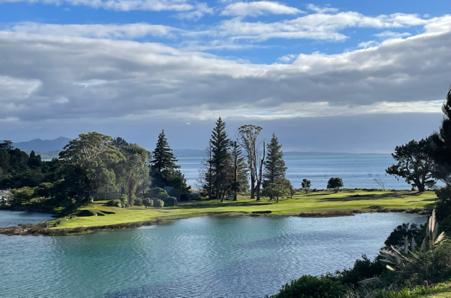
of the box thinking. You have three or four green-sites that would rival the very best in New Zealand. I will be sending more people your way for sure.
You really chose all the best green sites to maximize your property. Your green in the far coastal corner of the property does this so well. The triple green with the bunker and lower green level and water hazard. It is the interest you created that is so much fun. Onekakā can’t fit inside a box and it should not be contained by the world’s idea of a routing and par. It is just an awesome place to play golf.
You and Richard Barham have done such an amazing job with your property - really impressive stuff. If you ever end up doing that new green we discussed
drop a me line and I may try to volunteer some shovel time for you if the timing works!
Thank you again and it was so kind of you to host me there. “
- CJ Kreuscher, Director of Agronomy for Te Arai Links and the original Superintendent of Tara iti, who recently played both courses.
“Great day out at the Onekakā Links in Golden Bay. Stunning scenery. Some exciting holes and wonderful hospitality. It’s a very unique offering but lots of fun and risk and reward. Wonderful hospitality from President Chris Castle and Club Captain Linda Sanders. Highly recommended. “
- Barry Johnston, Wanaka

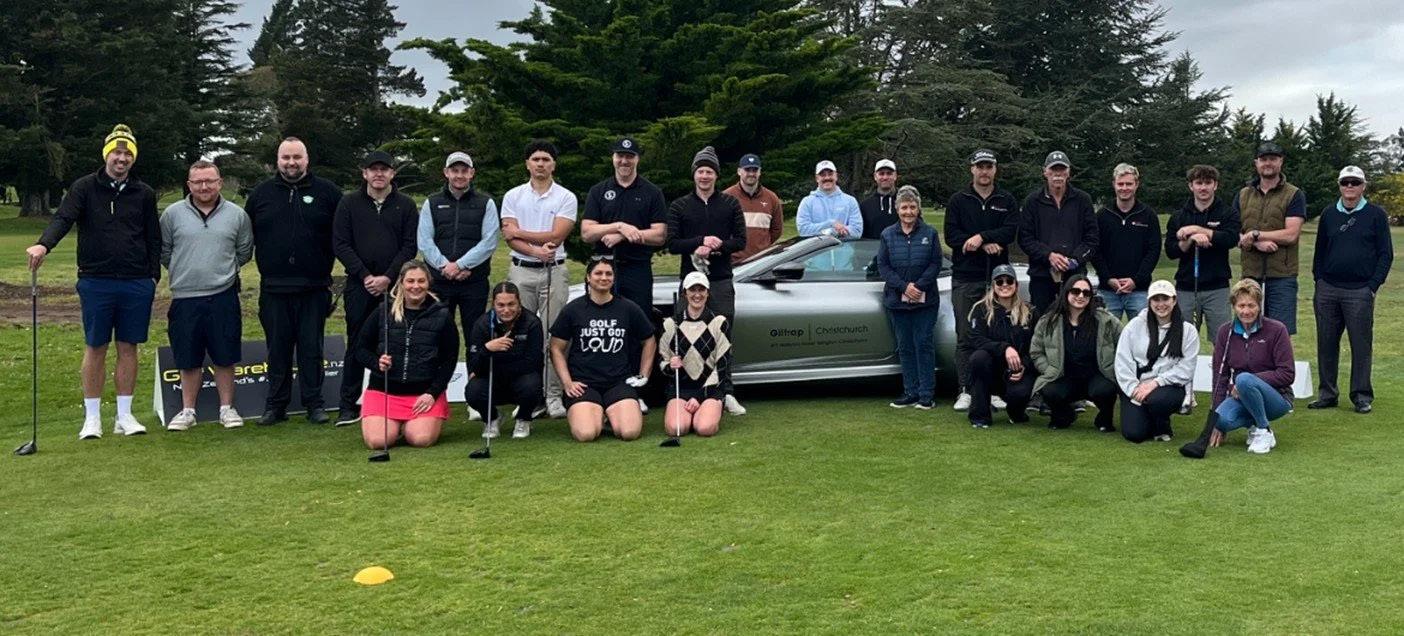
XDL Christchurch Regional Championship Ignites Legacy, Community, and the Road to Nationals
When the first tee lit up at the XDL Christchurch Regional Championship 2025, the sound of power hitters launching drives into the night marked more than just another competition — it signaled the beginning of a new legacy for Christchurch. For the first time, Canterbury hosted an official XDL Regional Championship, and the result was nothing short of electric. From the backing of Goodwin Excavations, to the roar of the crowd celebrating record-setting drives, the event proved that XDL is more than a sport — it’s a movement bringing community, business, and entertainment together.
The Christchurch championship was steeped in meaning. Back in 2017, XDL founder Olna Ford hosted New Zealand’s very first South Island Long Drive Championship in Christchurch. That moment planted a seed. This year’s event became a flashback — only bigger, louder, and infused with a fresh sense of ambition for the future.
“Christchurch will always be a landmark for us,” Olna shared. “What made this year powerful was the way sponsors and the community got behind it. One decision led to another, and suddenly, we had a full championship stage.”
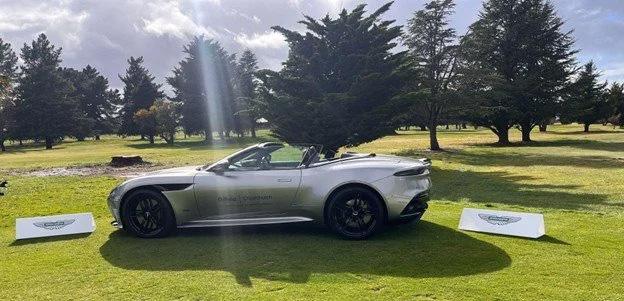
The inaugural Christchurch Regional wasn’t possible with-
sion with a 297m drive that had the crowd on its feet.
* Katie Dixon was officially named to the New Zealand Long Blacks team, joining an elite lineup of power hitters who will represent the nation on the international stage.
out the backbone of committed sponsors and supporters.
* Goodwin Excavations took the driver’s seat as Title Sponsor, setting the tone for the championship’s momentum.
* Waterways & Civil, Erect Scaffolding, and Thermaclad Insulations stepped up with category sponsorships, creating pathways for athletes across divisions.
* MC - Josh Henderson, local motorsport commentator kept the spectators and players entertained and up to date. Continued thanks to partners — including Giltrap Christchurch, Golf Warehouse, Recreation Station, Blueberry, World Traveller Riccarton, Sign Pursuit, Red DJs, Hurrells, Brilliant Rentals, and Airport Palms Motel thanks to Katie Dixon and Samantha Usai for driving our socials — elevated the event experience. And then there was Templeton Golf Club, who didn’t just host, but threw open their arms. Their staff went above and beyond to make sure the grounds, facilities, and atmosphere matched the occasion. The result? A championship that looked, felt, and sounded like something built to last.
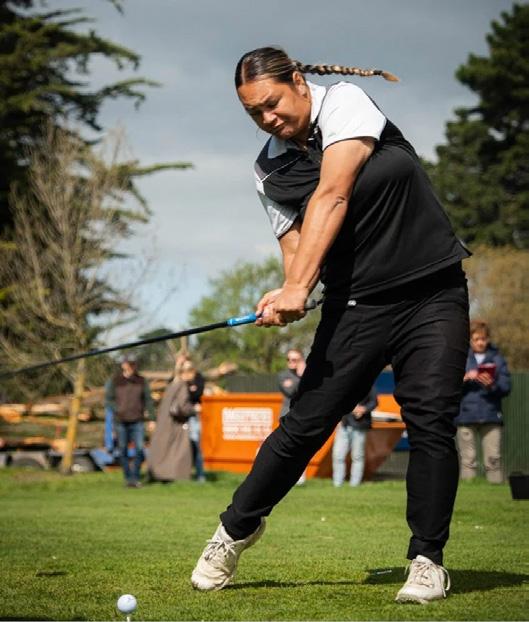
Every XDL event has its highlights, but Christchurch delivered moments that will be remembered for years to come:
* Young Jessie Mercer stole the show, breaking a new record for the women’s divi-
Moments like these show how XDL not only entertains but also creates pathways for athletes to rise to new heights.
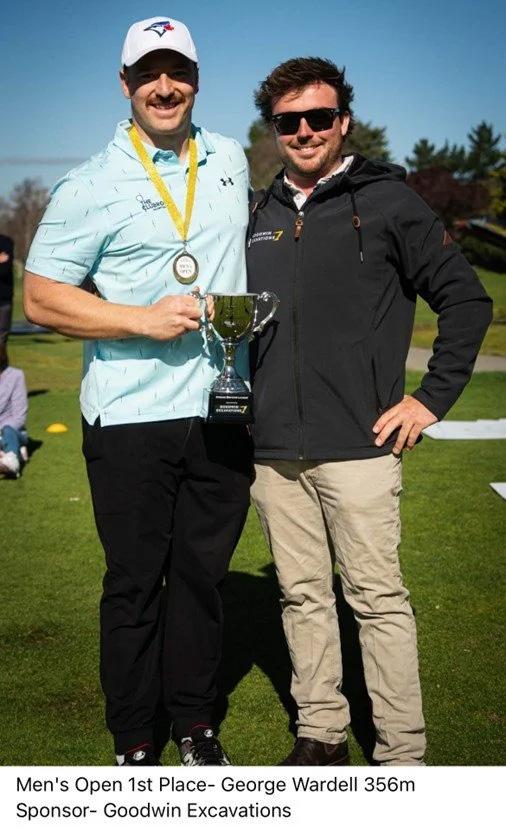
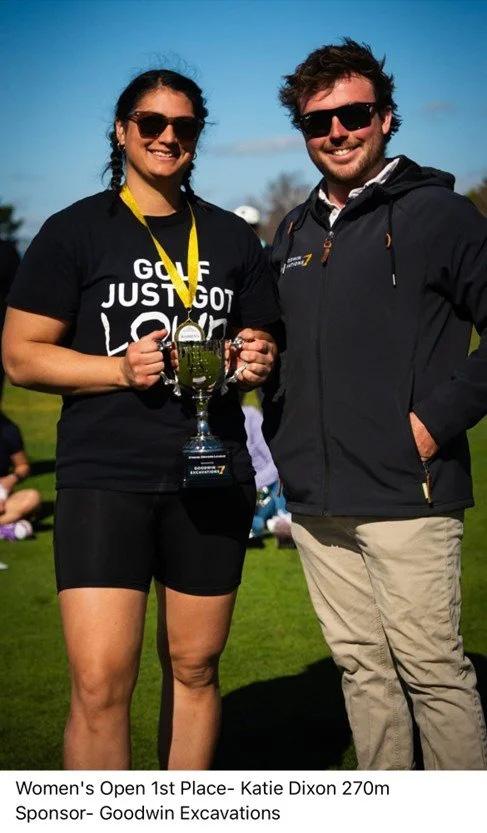
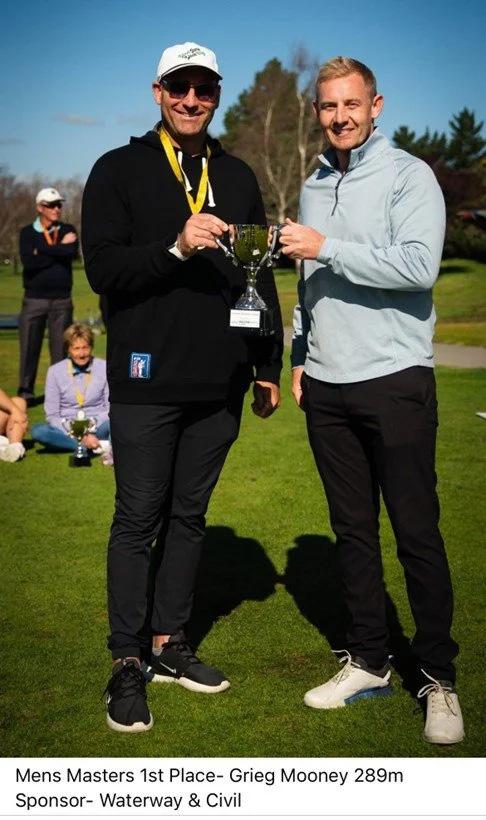
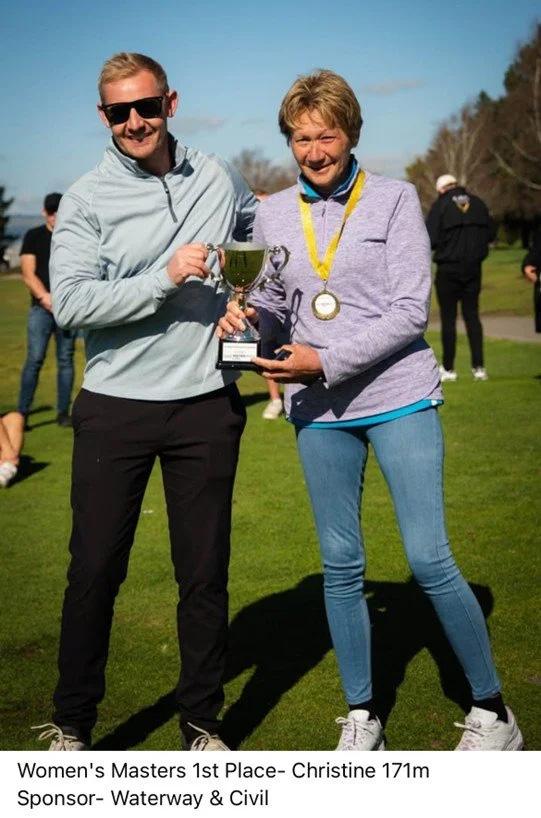
Men’s Open – Sponsored by Goodwin Excavations
* George Wardell – 356m
* Chris Charlton – 326m
* Andrew Storm
Women’s Open – Sponsored by Goodwin Excavations
* Katie Dixon – 270m
* Jessie Mercer – 222m
* Kate Bain
Men’s Masters – Sponsored by Waterway & Civil
* Grieg Mooney – 289m
* Andrew Storm – 253m
* Jim Lapsley
Women’s Masters – Sponsored by Waterway & Civil
* Christine Kinita - 171m Longest Drive Awards –Sponsored by Erect Scaffolding
* Men’s: George Wardell –356m
* Women’s: Jessie Mercer –297m
* Masters Men’s: Grieg Mooney – 299m
* Masters Women’s: Christine – 171m
The Christchurch Regional was more than just an event; it was a gateway. Athletes who qualified will now take their shot at XDL Nationals, and from there, the international stage beckons. But perhaps even more important was what the event sparked off the tee. Conversations are already underway for a bigger, bolder Christchurch event in 2026. With a foundation of strong local sponsors and a community that showed up in force, the appetite is clear: Christchurch is ready to be home to one of the premier stops on the XDL circuit.
Even when the course itself is closed, XDL events generate new streams of revenue for local clubs, showcasing how
sport can be both entertaining and financially empowering. The Christchurch Regional is a model of how clubs and communities can grow stronger through innovation.
This is XDL’s promise: to take a thrilling, fast-paced sport and connect it with business, tourism, and community pride.
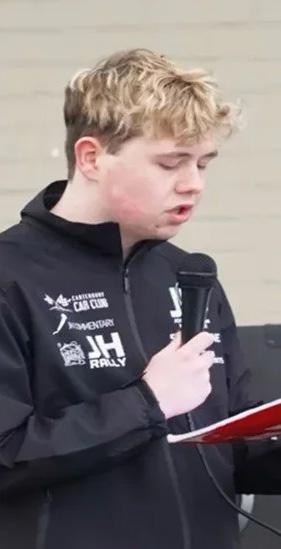
The XDL Christchurch Regional Championship 2025 is now etched in history as the first South Island regional to carry the official XDL banner. It will be remembered as the night when local businesses, athletes, and fans all came together to do something bigger than themselves.
And it’s only the beginning. 2026 promises to be bigger, brighter, and bolder. Christchurch has proven it’s ready. The stage is set. Because from one decision, a movement has begun — and its drive is only getting stronger.


Welcome to Greenacres Golf Club, where playing golf is a “fun” experience to be enjoyed. This beautifully maintained 18-hole layout, rated one of the top 40 courses in New Zealand, is conveniently located on the outskirts of Richmond, just a short drive from Nelson Airport. Set on an island, the club offers magnificent scenery and tranquil surroundings. The course is renowned as one of the best all-weather courses in the region and tests players of all abilities, young or old, high, or low handicaps .While this course is consid-
ered one of the most challenging in the top of the South Island it is a popular course for all playing levels. The scenic yet challenging links style layout of the course in a tree lined parkland setting, is a pleasure to enjoy. Greenacres has everything a good (and growing) golfclub should have – a great course and facilities, and fab-ulus people that are friendly and welcoming and want you to be part of the club, even if just for one day We look forward to seeing you soon. www.greenacresgolfclub.co.nz

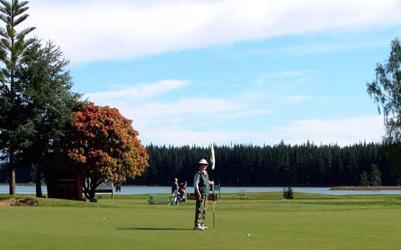


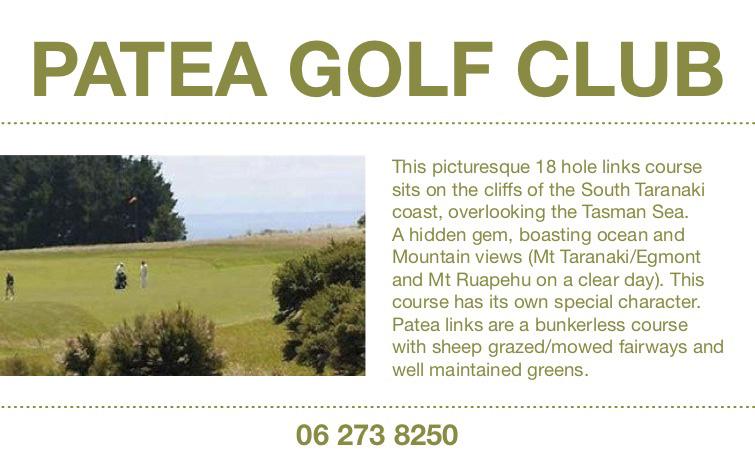
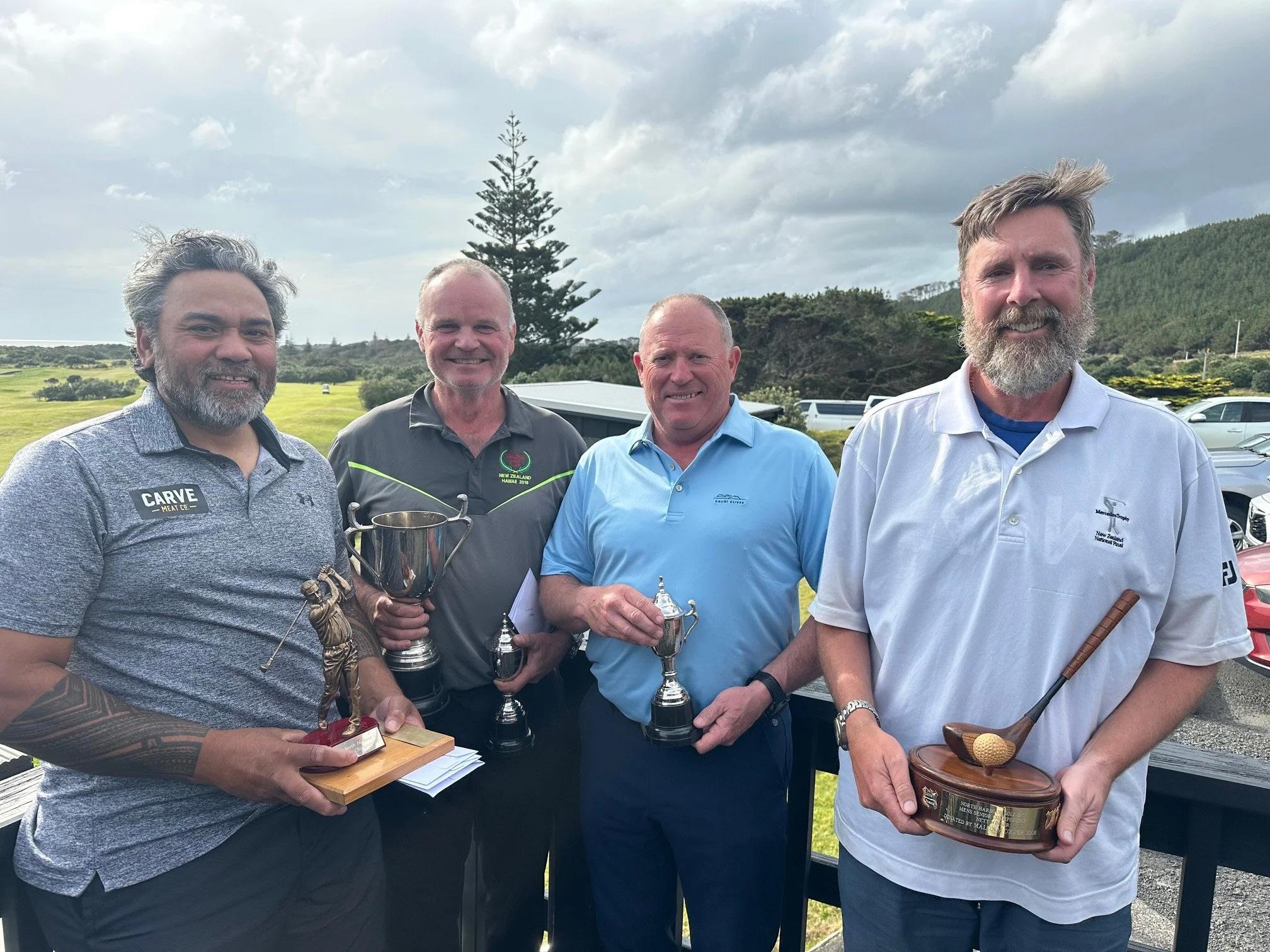


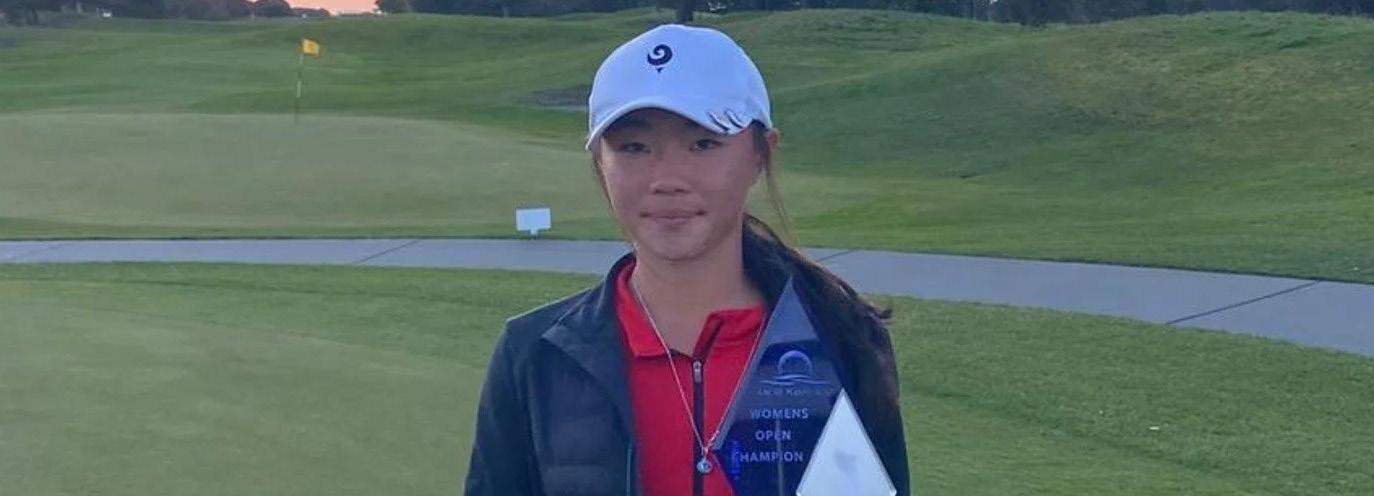
The Bay of Plenty Open, doubling as the North Island Stroke Play Championship at Whakatane Golf Club, proved a true test of patience and resilience, with brutally tough conditions challenging players across all four rounds.
In the women’s championship, Golf New Zealand Development Squad player Teresa Wang produced a commanding wire-to-wire performance to claim the title. Fresh off her victory at the New Zealand Under 16 Age Group Championship, Wang showed composure beyond her years, handling the gusting winds and conditions better than anyone in the field. Remarkably, she was the only player to break par for the week. “It feels pretty good,” Wang said after the win. “I think
I played okay despite the weather, because it was pretty windy. The course is pretty long for me, and when the wind picks up it gets even longer and really hard. Last week when I played in Wellington it was similar conditions, so it really helped me prepare my game for this tournament.” View the full women’s leaderboard here.
Her next challenge comes across the Tasman later this month: “I’ll be playing the Jack Newton International in Australia, I’m really excited and looking forward to that.”
The men’s championship provided drama right to the end. Golf New Zealand Academy member Mitchell Kale mounted a stunning comeback, overturning a seven-shot deficit heading into Sunday. Kale carded rounds of 68 and 69 across the final 36 holes to set the club-

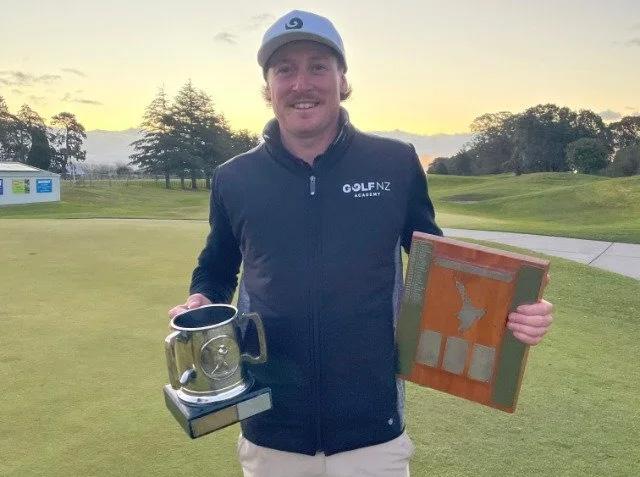
house lead. Glenn Solomann was right there with Kale, but a bogey at 16 left the door ajar. In a big moment, he responded in style by chipping in for birdie on the last to force a playoff.
The playoff saw both players match pars on the first extra hole before Kale delivered the decisive blow on the second, holing a clutch birdie putt from the back of the green to secure back-to-back Bay of Plenty Opens and, with it, his first North Island Stroke Play crown.
“Yeah, it’s pretty cool,” Kale reflected. “I had a bit of time off with injury, this is my fourth tournament back, so it was good to feel under the gun again. I didn’t really have my best stuff at all, so it was good to get the win.”

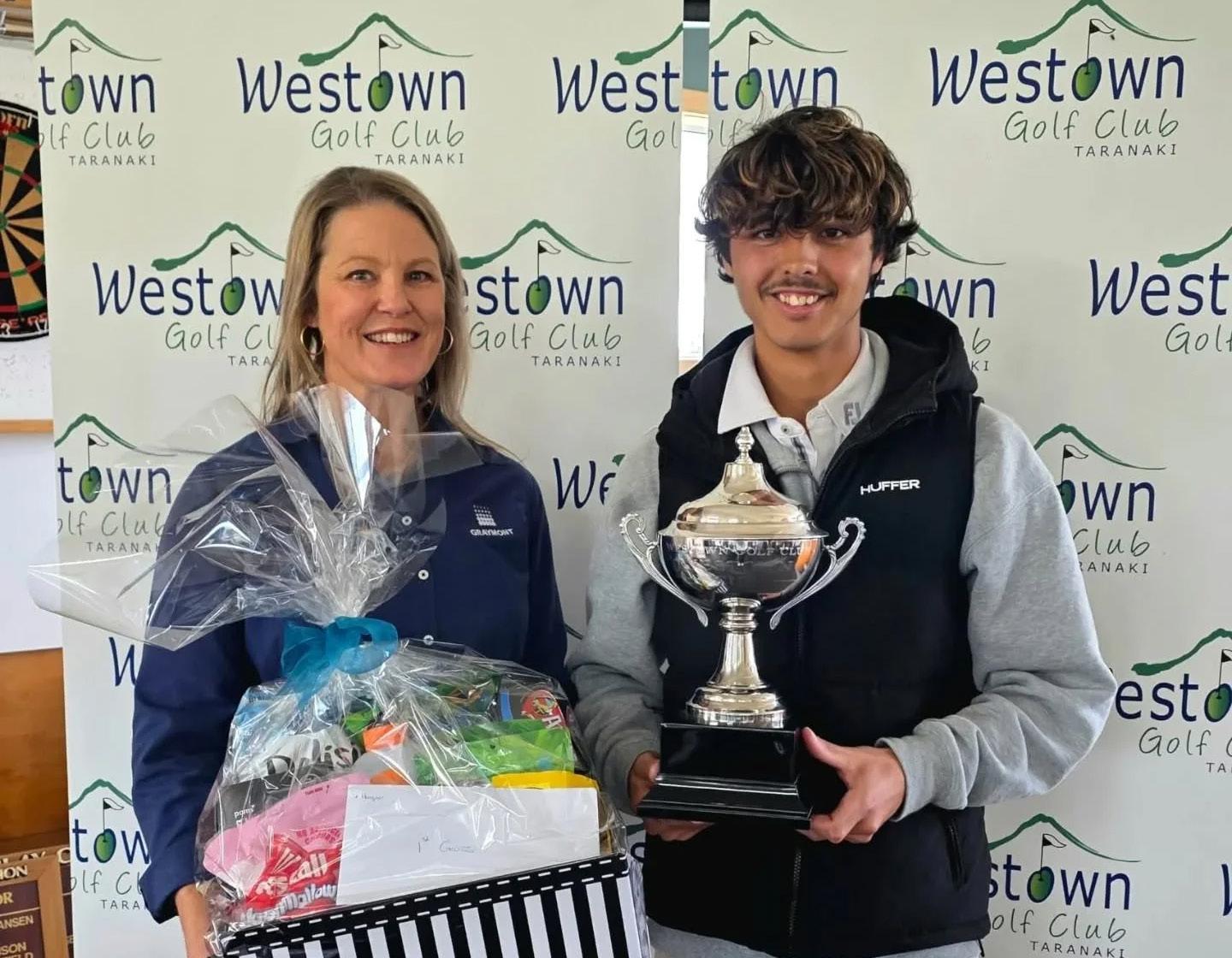
Kingston Taylor-Voyle was the winner recently of the Calcimate Westown Open winning in a play-off against Ben Joseph. Kingston had rounds of 73, 76.
Jackson Moorhead – took out the Un-
der-20 title and came third in the overall event with rounds of 77, 73
Kingston Taylor-Voyle 73,76
Ben Joseph 79,70
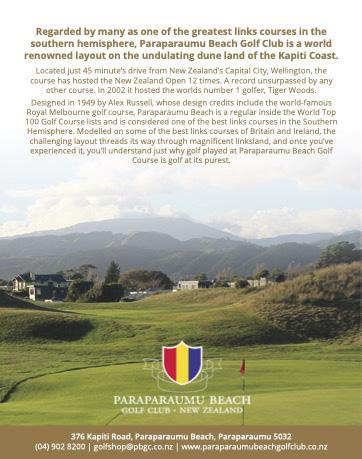
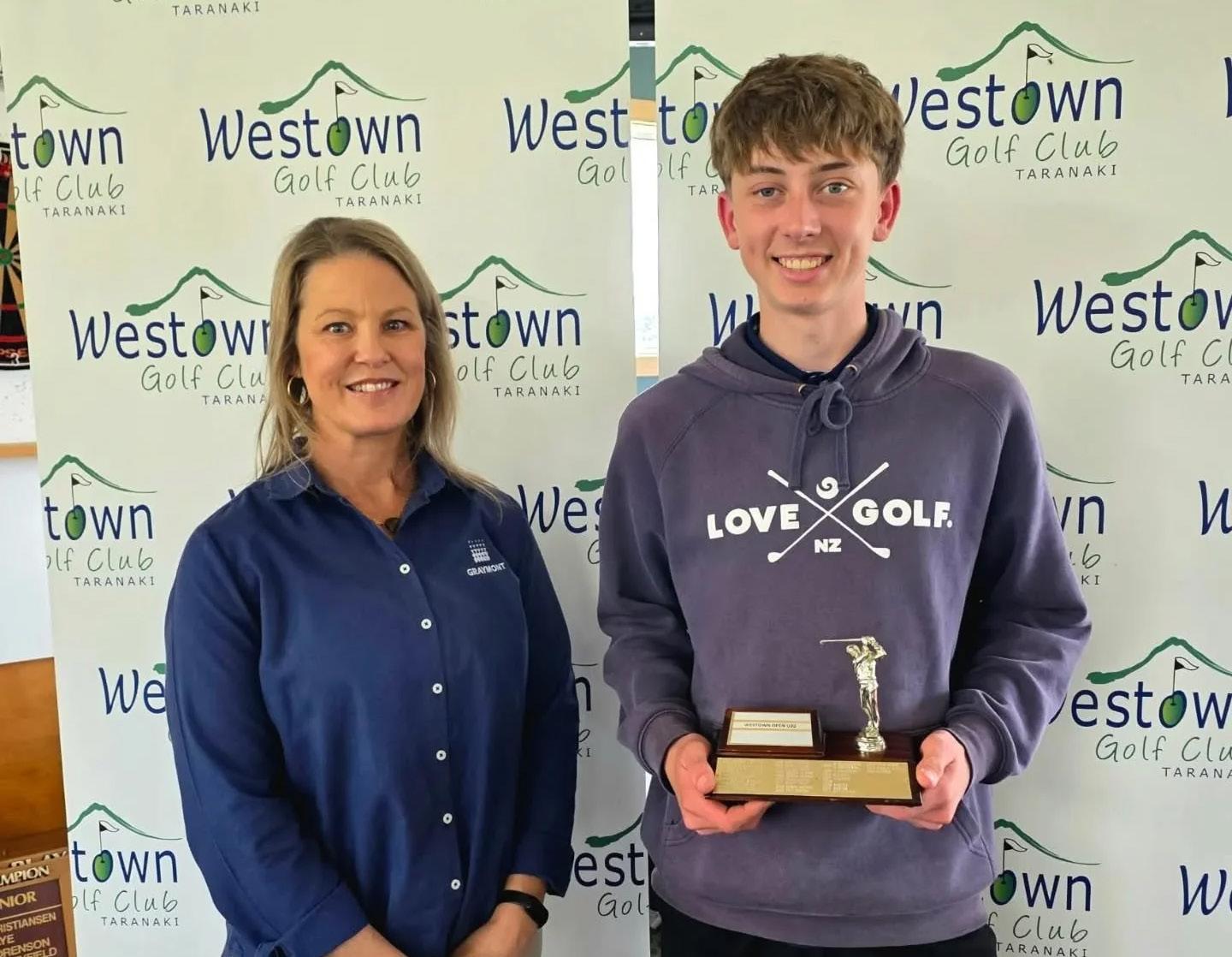
Dean
Max Van Beers 73,80
Aarun Langton 80,75
Brian
.The conditions put everyone to the test with heavy downpours and gale-force winds.

025 Eagles National U17 Championships, 2025 Booth Shield Junior Interprovincial Championships at
Boulcotts Farm Heritage Golf Club ; two great events, seeing more than 100 children participate from all 15 NZ provinces.
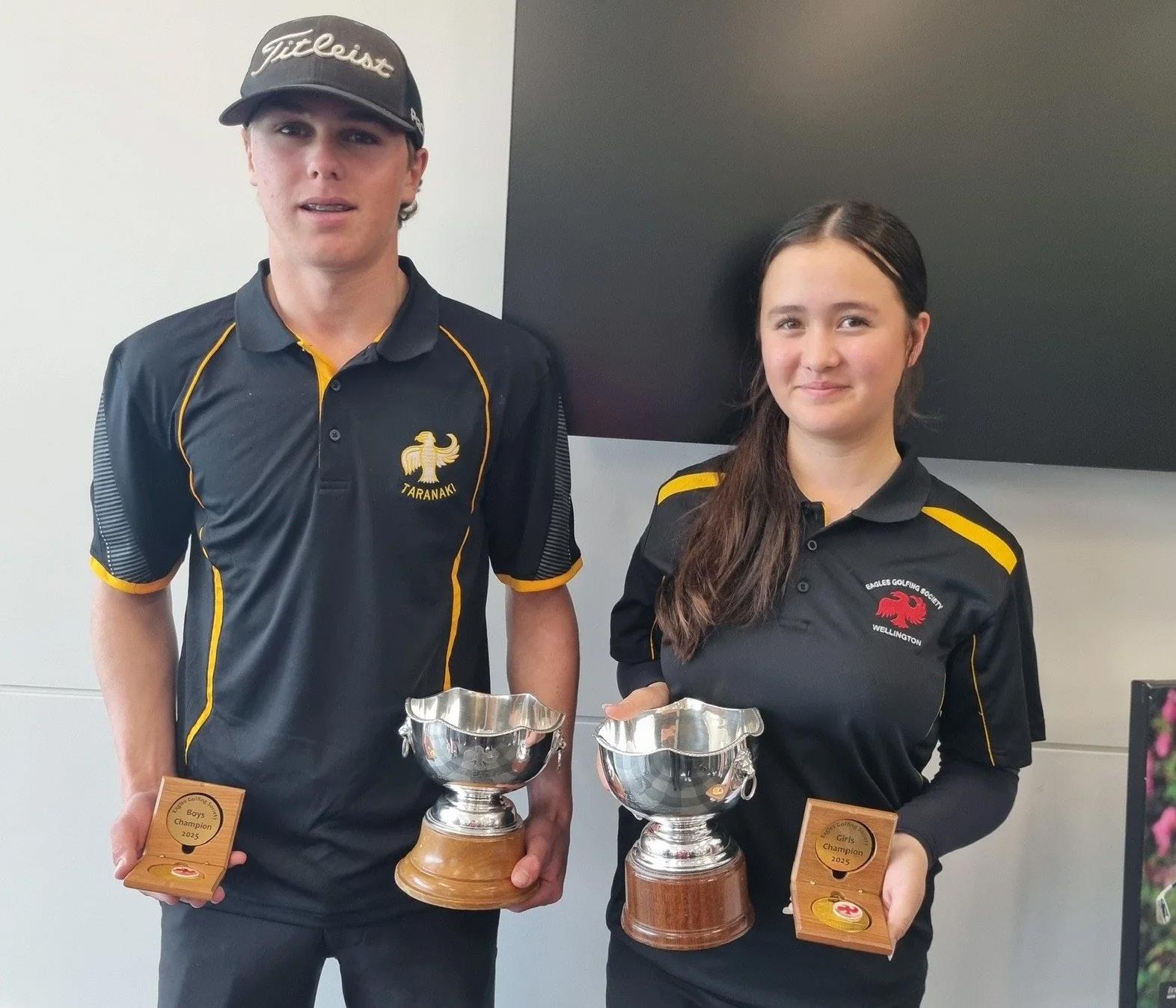

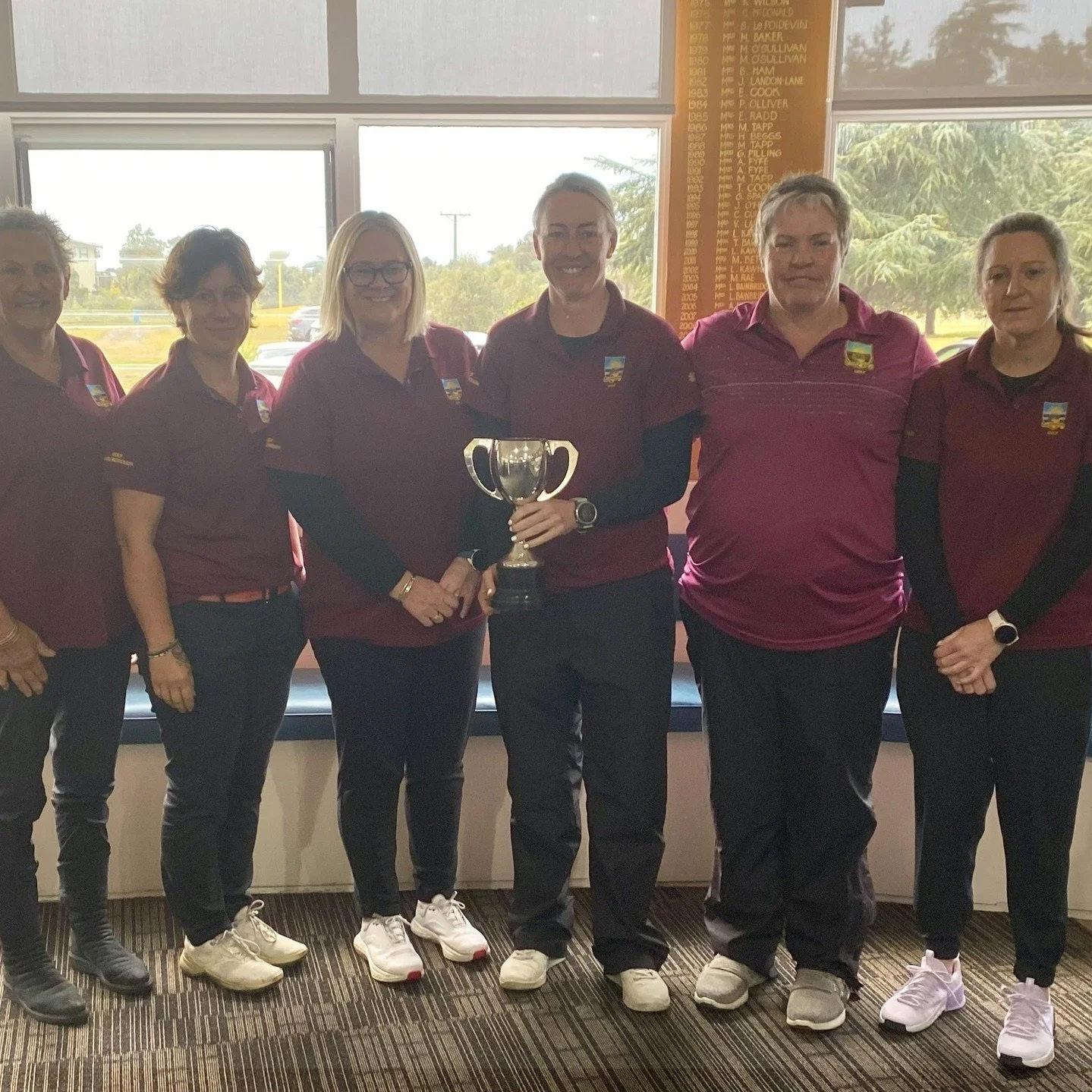
The Rarangi Tasman Quad and Westrupp Cup were the fifth and final Tasman trial events.
We were spoilt with great weather on the Saturday which allowed us to complete the first 36 holes of match play. However, day two was abandoned without a ball being struck due to excessive and dangerous winds.
The Ladies Eastern team with Sue Murray, Helen Henshall, Andrea Thomas, Amber Boyce, Jo Rainbird & Emily Stenhouse had comfortable winds against the
Northern & Western on day one. Eastern were therefore awarded the Westrupp Cup. (Photo attached of the Eastern team).
Kobe Hart, Ben Crawford, Elijah Barney, and Mike Croad all had two wins on day one. The Nelson Senior men’s team had two wins against Buller Westland and Marlborough. While Marlborough had two wins in the Intermediate division.
Results: https://www.golf.co.nz/tasman-pennants 2

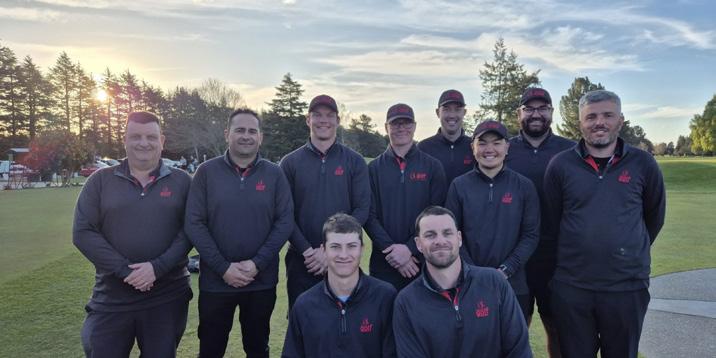
Canterbury kicked off their 2025 Representative season in a pleasing fashion during the opening fixture in Ashburton recently with wins to all teams across the ages and genders. With all teams featuring player(s) on debut for Canterbury at this level, it was a great opportunity for existing and new players to put their best foot forward with future season rep fixtures in mind.
In the Men’s space, the team started the fixture well in the reverse singles format with 6 of the 8 players recording victories. McGill came through with a strong 7/6 victory alongside similarly convincing 6/4 wins from Cam Grant and Scott Manyweathers. On debut was teenager Mitchell Redmayne who enjoyed his first taste of senior rep golf but was unable to overcome his opponent falling to a narrow 2/1 defeat. Onto the afternoon singles round and an identical scoreline with Canterbury again winning 6 of their
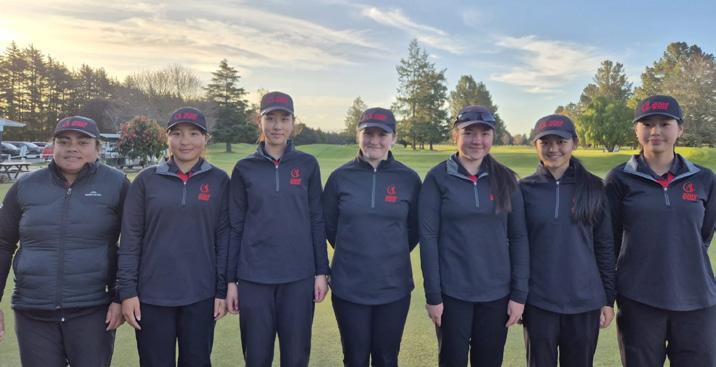
8 matches. Yuki Miya bounced back from his morning defeat to win 5/4, with Mike Toeke, Adam Winter, Cam Grant, Scott Manyweathers, and McGill all making it 2 from 2 on the day resulting in an overall 12-4 victory.
In the Women’s space, the same format was in play although with shots given at the number 7 & 8 positions given the disparities in handicap indexes. Despite this, the ladies still had a strong morning winning 6 of their 8 matches including strong wins to Zaria Bourne 5/3 and Alice Fry 5/4, the latter making her Canterbury debut. Lannie Inoue and Junie Change also getting hardfought wins 2/1 and 1Up respectively. Into the afternoon and a far closer contest with many of the matches in the balance to the end. Fry carried on her morning success with a strong 7/5 victory, with Junie Chang and Olive Tapu also winning comfortably. A 1Up win to Lexi Thomson Hall and 2/1 win to Vanes-



sa Lim was enough to give Canterbury 5 wins to Aorangi’s 3 leading to an overall 11-5 team victory.
The Men’s Masters contest, as it always is in this fixture was a tight affair, and as it turned out in the morning matches the two provinces could not be separated with 5 wins a piece in this 10 player format. For Canterbury, Riki Borrel and Joseph Larson were both debuting for Canterbury at Master’s level alongside some other experienced players, and it was ultimately those experienced players who claimed the morning wins. Aaron Forsyth, Jason Sincock, Andrew Dufton, Alisdair Reid, and Jonathan Stieller all getting the better of their opposition. Onto the afternoon and with the team result in the balance the men rallied well with 7 of the 10 men getting wins. Larson bounced back for a strong 7/6 win while Forsyth, Dufton, Reid, and Stieller also recorded wins to make it 2 from 2 on the day for

them all. Final team score 12-8. Finally in the juniors, 4 players were set to do battle in the same format as above with shots being given again from the Canterbury players to their Aorangi opponents. Unfortunately, one of the Aorangi players withdrew on the day meaning there was now one no contest in each round. Despite this, 2 of the 3 matches in the morning round were great contests with the matches of Jono Fry and James Walker both finishing in ties. The other match, Darren Kung in his Canterbury Junior debut performed very well winning comfortably 8/7. In the afternoon match the boys were more convincing all recording wins. Shunsuke Nakamura, on his Canterbury debut prevailed 4/2 with James Walker also winning 5/4. Kung’s match was a far tighter affair this time going all the way but ultimately winning 1 Up leading to an eventual 7-1 team win.

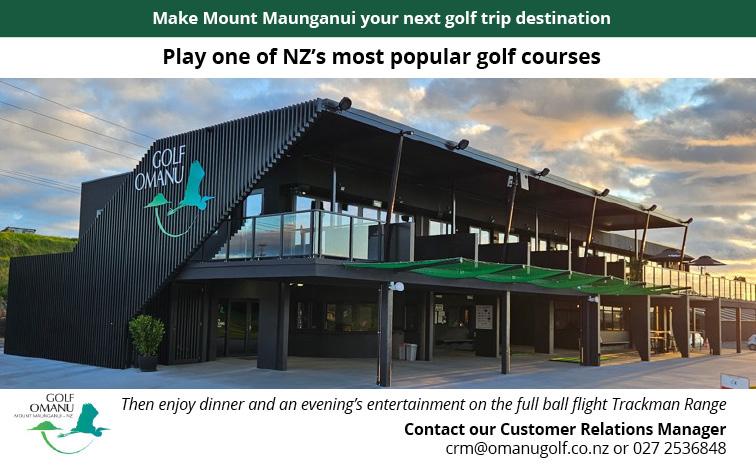
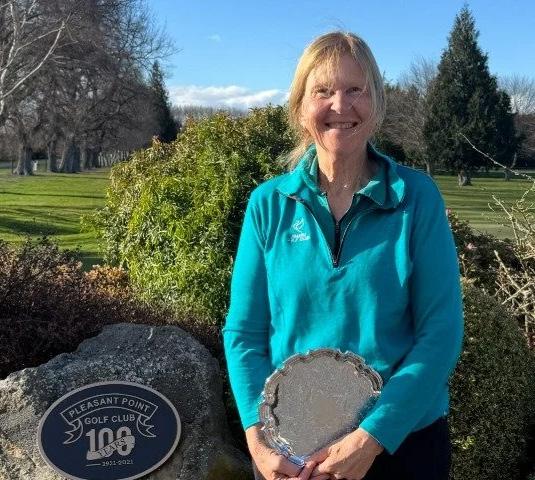
The Annual Aorangi Women’s Veterans Tournament took place at Pleasant Point Golf Club was played recently in warm and pleasant playing conditions. The dry, well-presented course was a welcome change for players, who appreciated not having to clean their golf balls after every shot, as had been necessary in recent months.
A field of twenty-four pairs, representing ten clubs, competed across 2BBB Stableford, gross, and a medal round. The day concluded with the trophies being presented by Aorangi Golf Life Member Lois Beattie.
2BBB Stableford Results
Heather Mills & Shelly Flintoff (Pleasant Point) – 47 points
Lynn Stratford & Frances Mulvey (Temuka) – 47 points
Daphne McDonnell & Kerry Pevy (Ashburton) – 46 points
Mary-Lou Watson & Judith Webb (Ashburton) – 46 points
Julia Knight & Karen Devlin (North Otago) – 46 points
Judy Hamer & Pat Duffy (Pleasant Point) – 45 points
MeeSook Choi & Elisabeth Thorp (Gleniti) – 45 points
Jo Peacock & Sue Newman (Tinwald) – 45 points
Trophy Winners 2025
Hedges-Kennard Trophy – Best Gross (Overall):
Lynda Brown (Timaru) – 83 Gross
2nd: Julia Knight (North Otago) – 83 Gross
Clarkson Tray – Best Nett (60–69 years):
Lynn Stratford (Temuka) – Nett 70
2nd equal: Mary-Lou Watson (Ashburton) & Leanne Breayley (Mt Nessing) – Nett 71
Euni-Peg Trophy – Best Stableford (70+ years):
Morna Hogan (Timaru) – 40 points
On countback from:
Pat Duffy (Pleasant Point)
Frances Mulvey (Temuka)
Judith Webb (Ashburton)
Sue Newman (Tinwald)

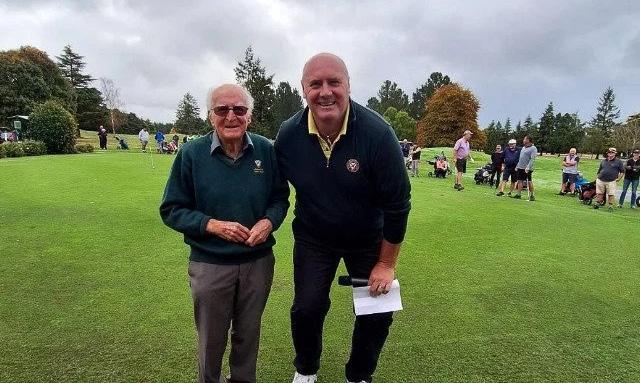
For more than six decades, golf has been a constant in Bruce Leighton’s journey - from his early days at Ashburton to cherished experiences abroad. He has lived the game in every sense: as a competitor, a club stalwart and a proud life member. Following his recent 99th birthday celebrations, Bruce shared his story with Golf New Zealand in his own words.
They say golf is a game for life, and few embody that more than Ashburton Golf Club’s Bruce Leighton.
Reaching that milestone is believed to make Bruce the oldest active golfer in New Zealand, as he still is seen weekly at the club with Ashburton’s ‘Nine Holers’.
“They are a great crew,” Bruce says. Bruce started his golfing life when he moved to Ashburton in 1958, about the time the club made the transition to its new Brandon course. He joined soon after and with just a couple of lessons soon found his feet. Breaking 100 for the first time was his initial success, then reducing his handicap to eight and producing his best round of 78.
Along the way, Bruce captured the Inter-
mediate, Junior A, and Junior B Championships, achievements he is still proud of.
In a span of more than 60 years, Bruce estimates that he has played nearly 3,000 rounds of golf at 50 per year. With four par-3s per round, that’s roughly 12,000 tee shots. One of them landed in the cup for his only hole-in-one so far.
“It took me long enough!” Bruce jokes.
The chances of an average golfer making a hole-in-one are at about 12,500 to one, so Bruce is a tough critic considering his estimate of attempts is much less than that ratio.
A standout golfing memory came during a trip to the United Kingdom in 1987, which happened to coincide with the British Open at Muirfield. Bruce attended and was fortunate to watch legends like Arnold Palmer, Gary Player, and Nick Faldo up close. The following week, he achieved a lifelong dream by playing the Old Course at St Andrews.
A sharp up and down on the fabled 18th green even elicited applause from a small group of onlookers.
“What a thrill,” he said.
Golf to Bruce has never been about the

scores, the game served as a comfort and form of therapy in difficult periods of his working life.
“To be able to get out there to golf, put that little white ball on the tee, endeavour to coax it down the fairway, then into the hole, I could not think of anything else. It was the best therapy I could ever have.”
And friendship and community were no less important. From eccentric mates to familiar characters, Bruce treasures people he has met along the way.
“The fantastic people that I met up with and played my golf with, they are a good outfit.
He recounts a story about one of the many characters he’s played golf with over the years.
“I was paired with one of these and when we reached the 18th tee our opponents informed us that they were one up in the ‘haggle’.
“My partner had complained and insisted on being square. Cards were checked and he was right.
“I thanked him for this and his reply was just ‘Well, you don’t think they kept me in
Standard 4 for two years for nothing.’”
Bruce paid the game back in club service. He was a member of the committee, President in 1993–94, and chair of the 1995 Centennial Committee.
“It has been my privilege to serve,” he says.
In 2013, at the age of 87, Bruce pulled off the rare feat of playing to his agetwice. First, he carded an 87, and two weeks later, he followed it with an 85.
Bruce will be the first to tell you that golf has given him much: purpose, therapy, friendship, and joy. Above all, he credits his wife’s encouragement for allowing him to live such a lengthy and fruitful golfing life.
“My golfing life has been so much of my life, and I am sure that it has helped me to last as long as I have.”
Golf New Zealand would like to congratulate Bruce not only on his 99 years of life but for is contribution to golf over 60+ years involved in the game on and off the course. People like Bruce make golf what it is; a game for life that can be enjoyed by all.

